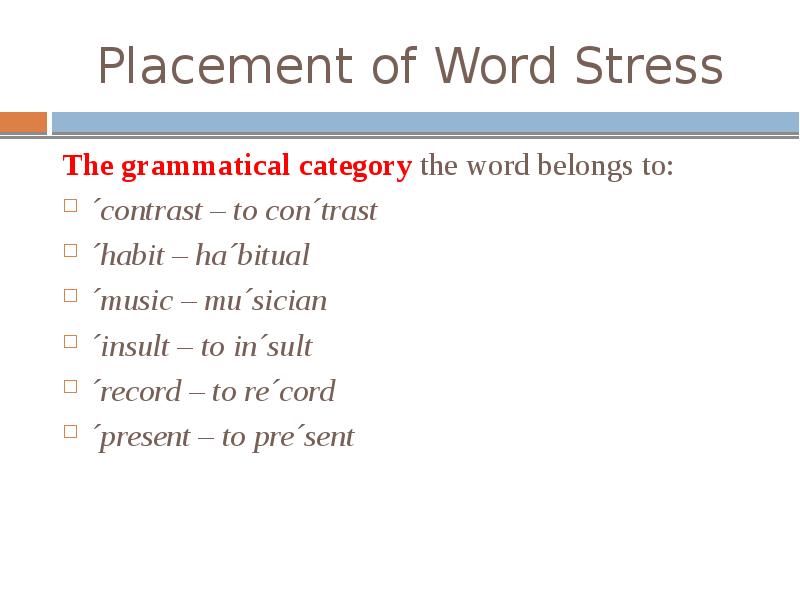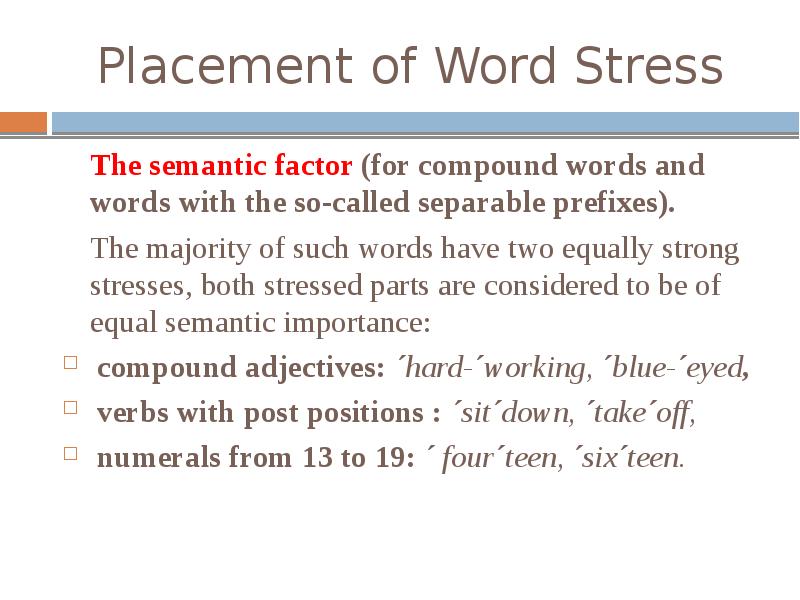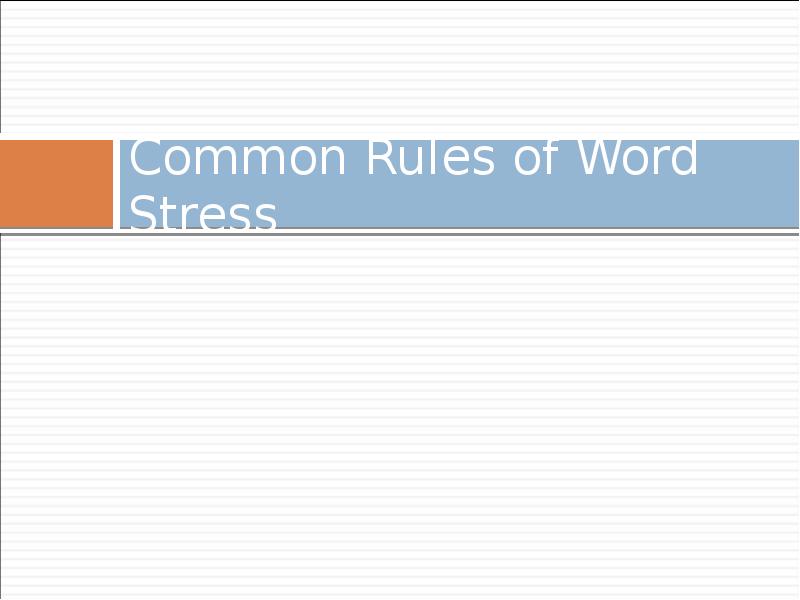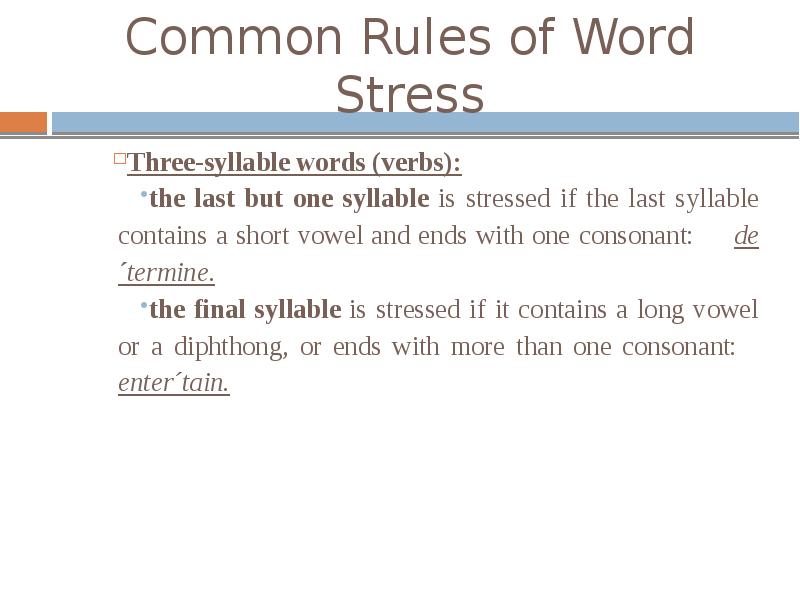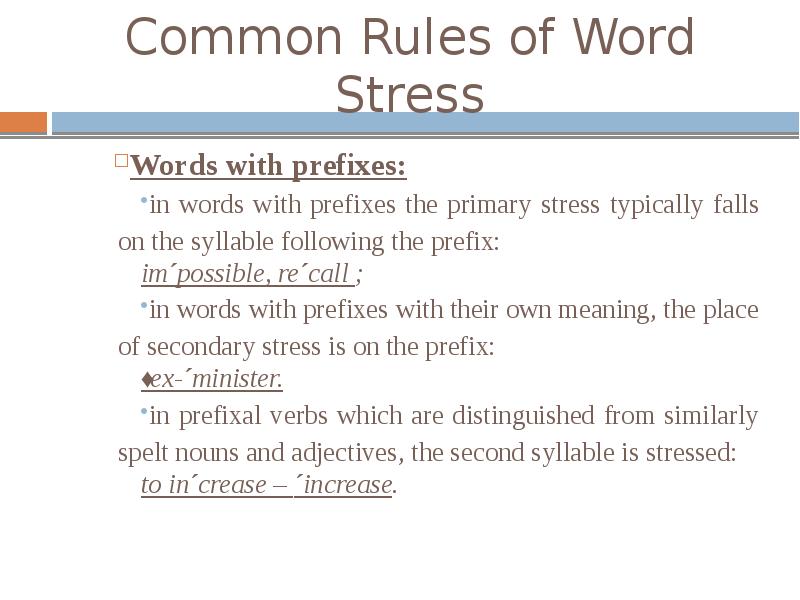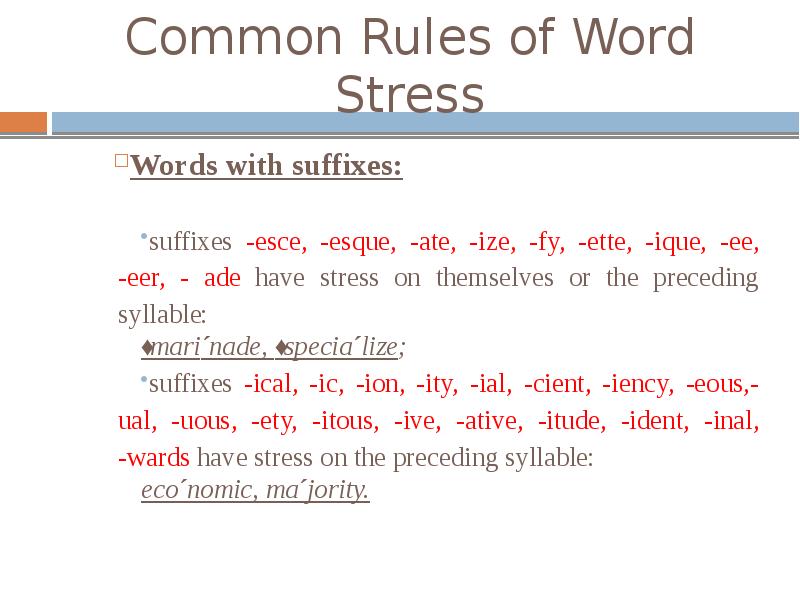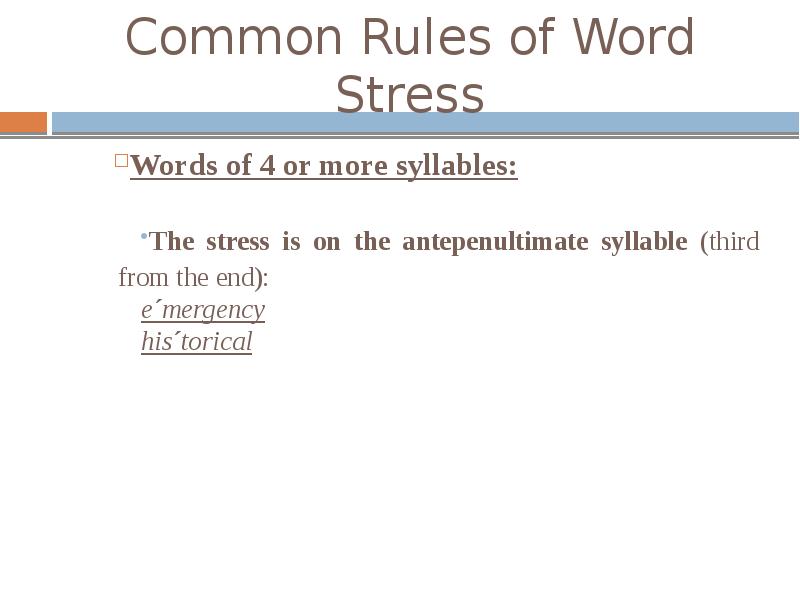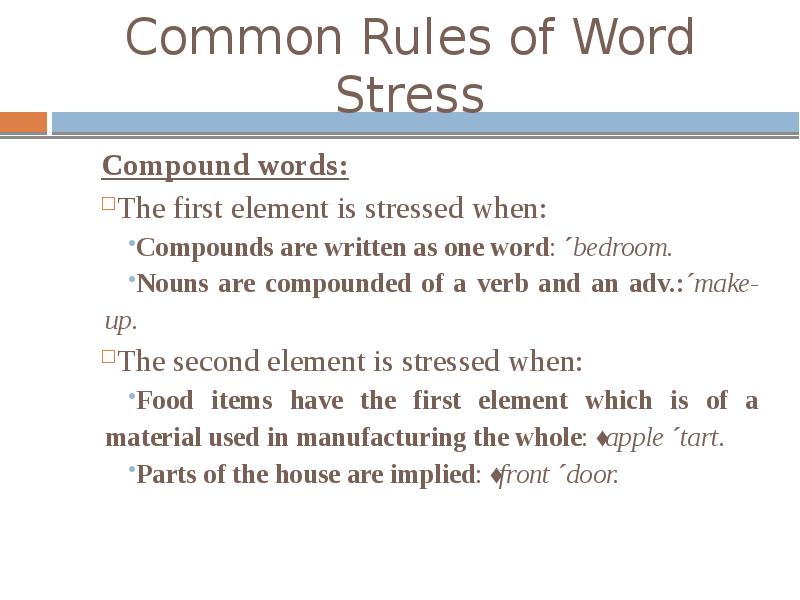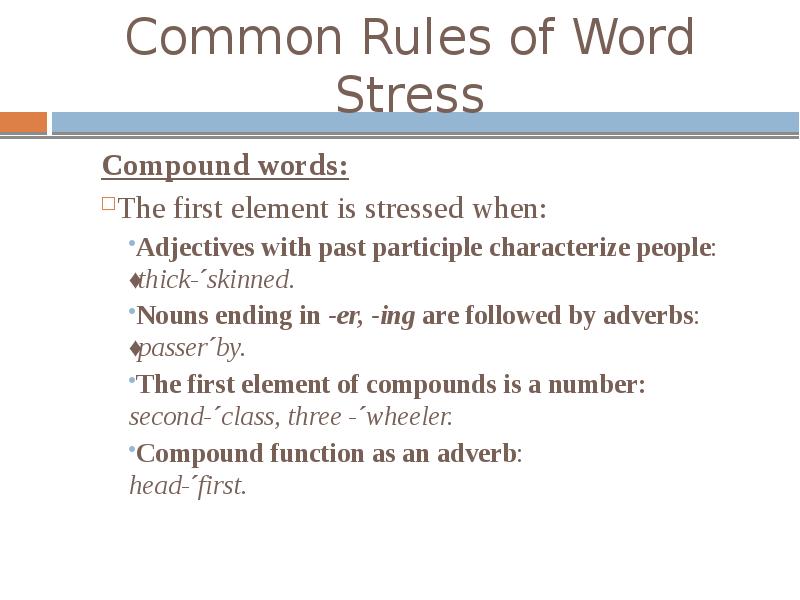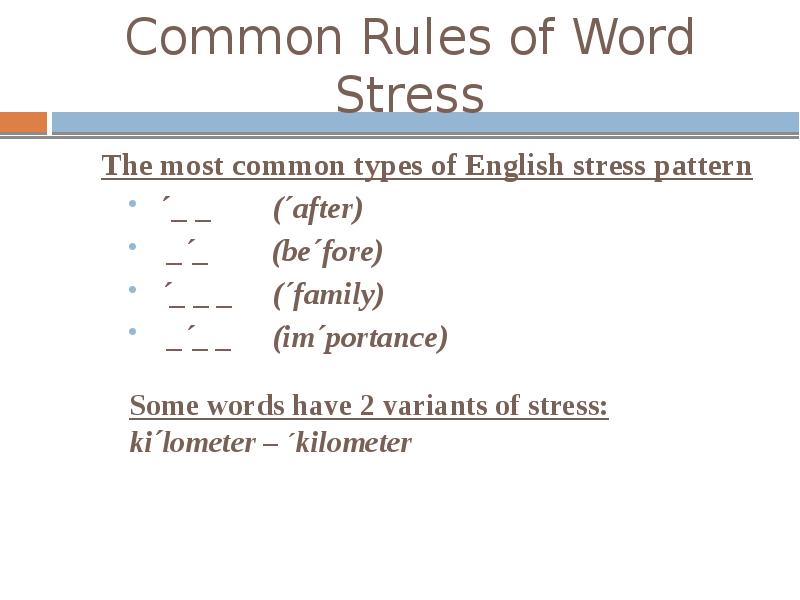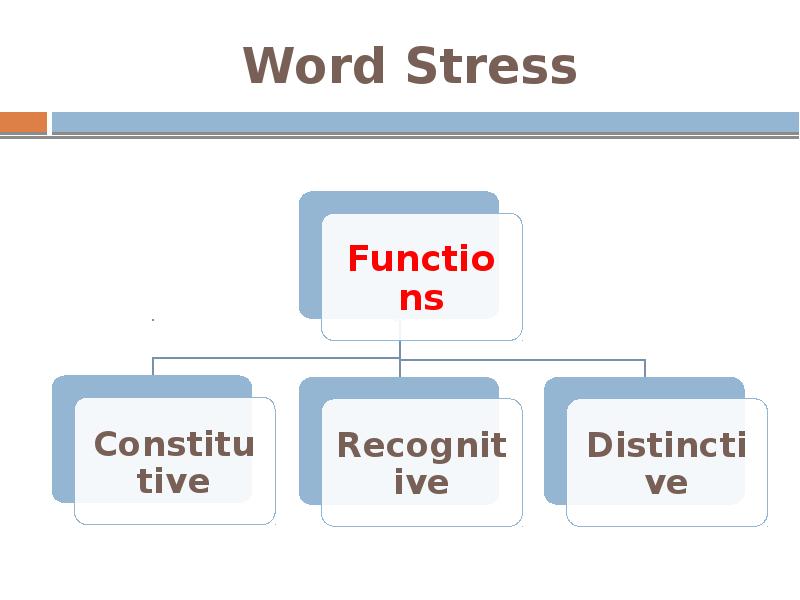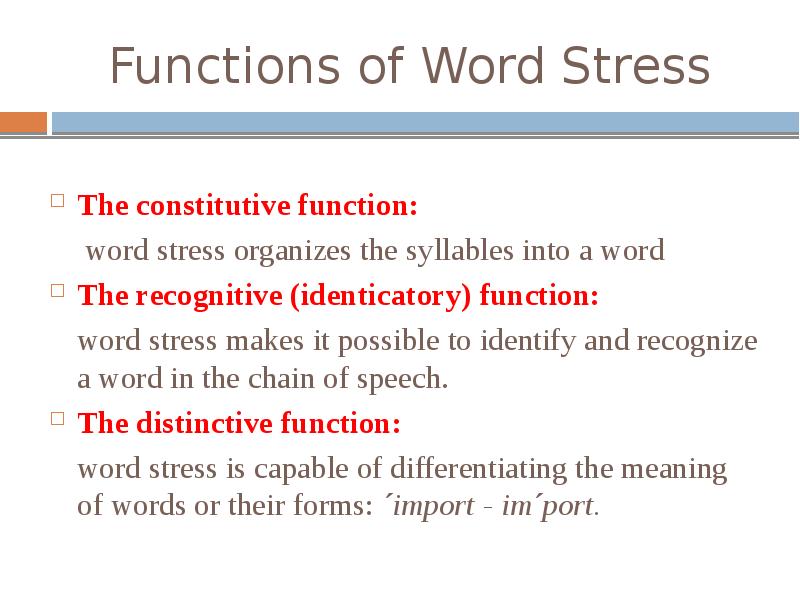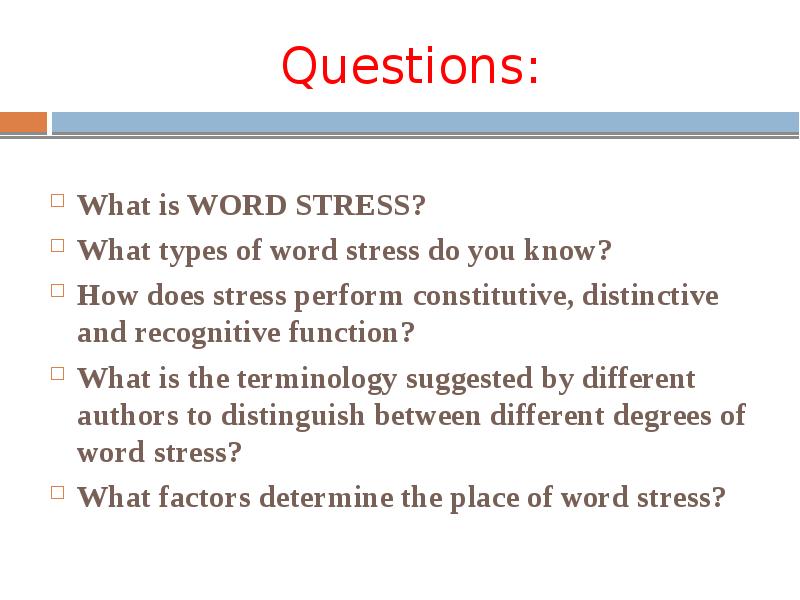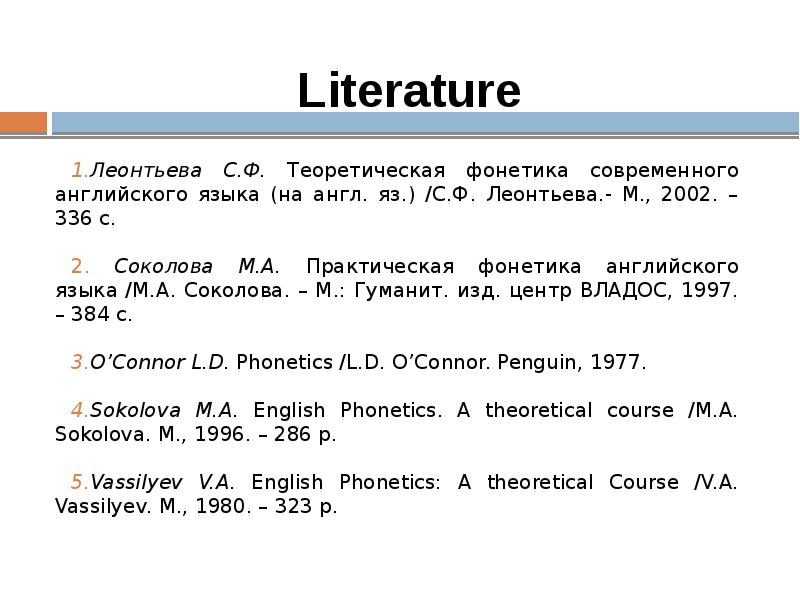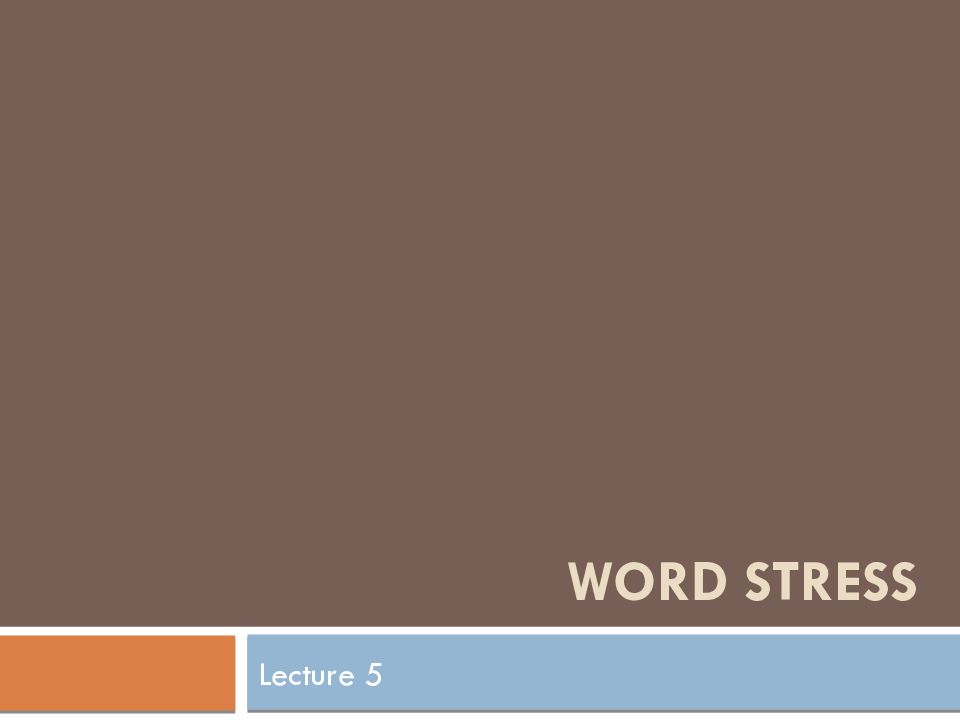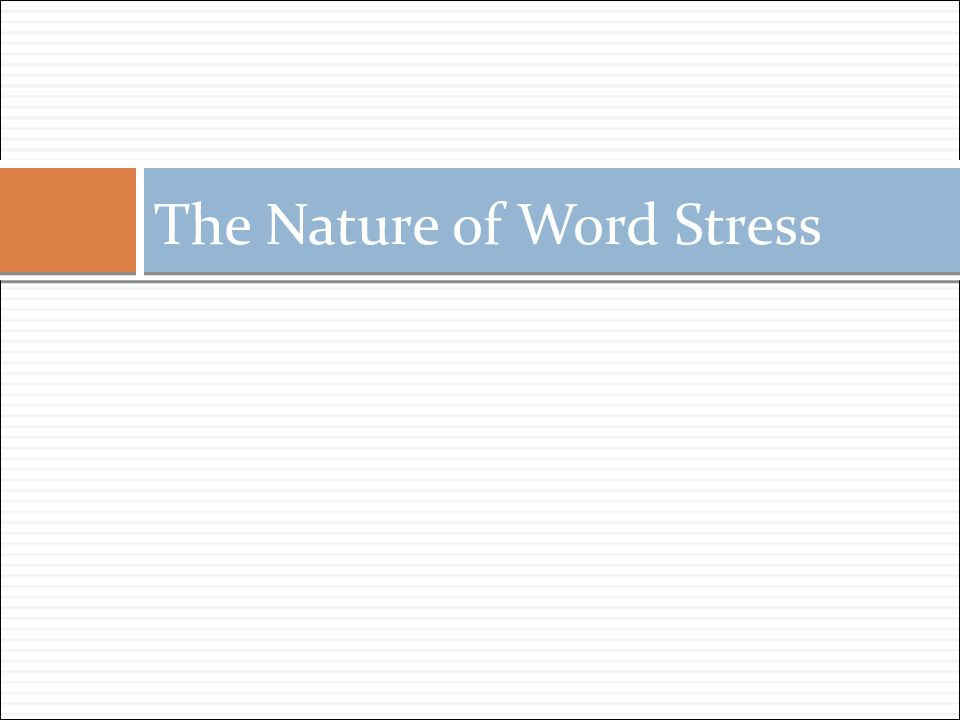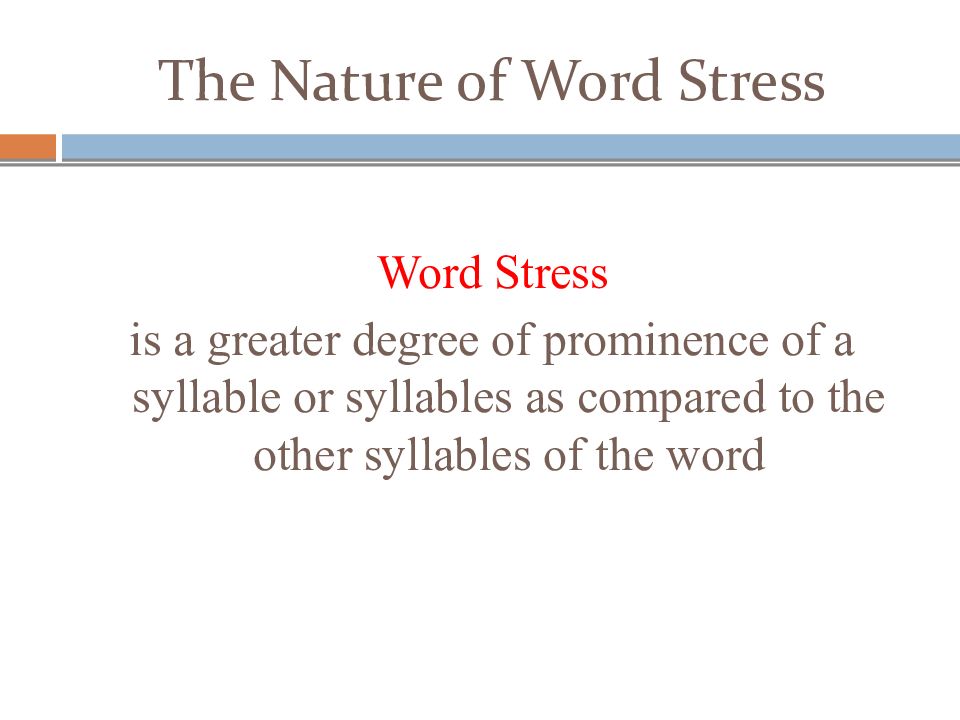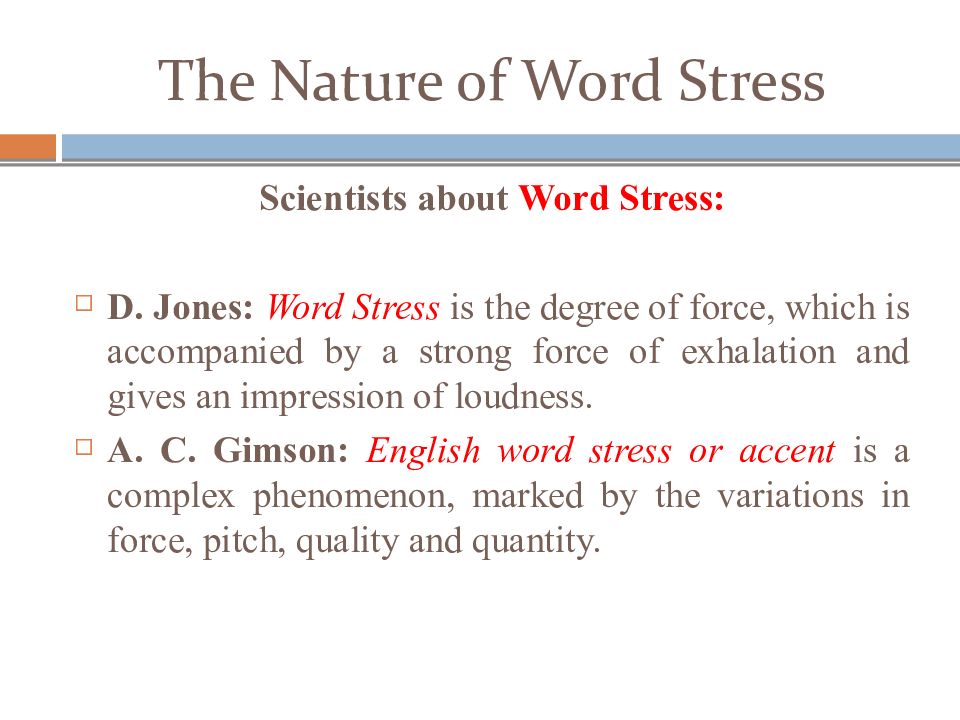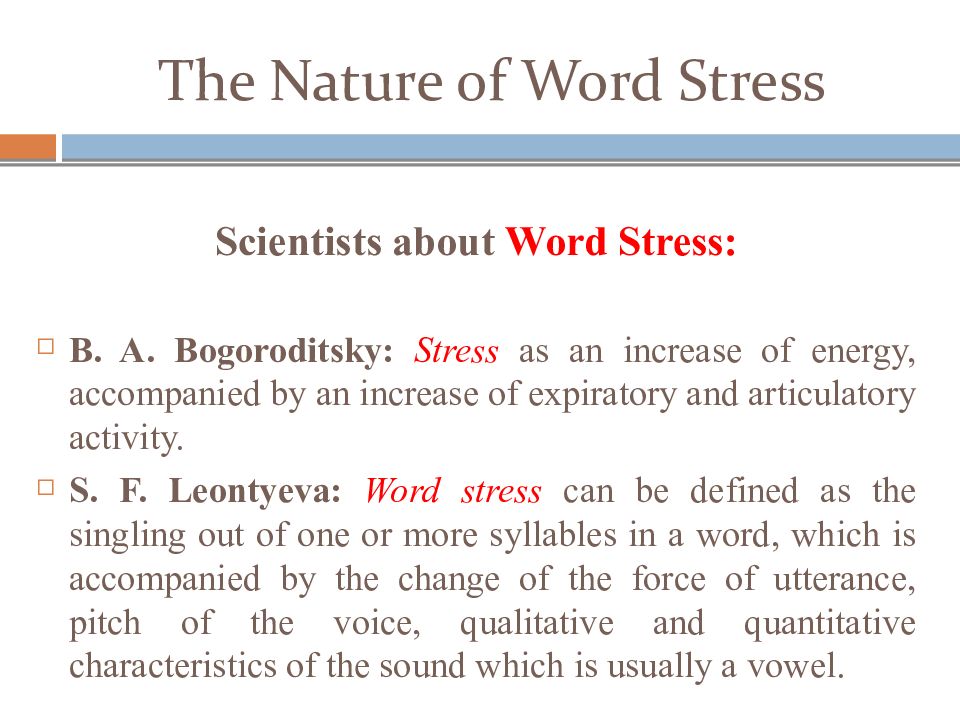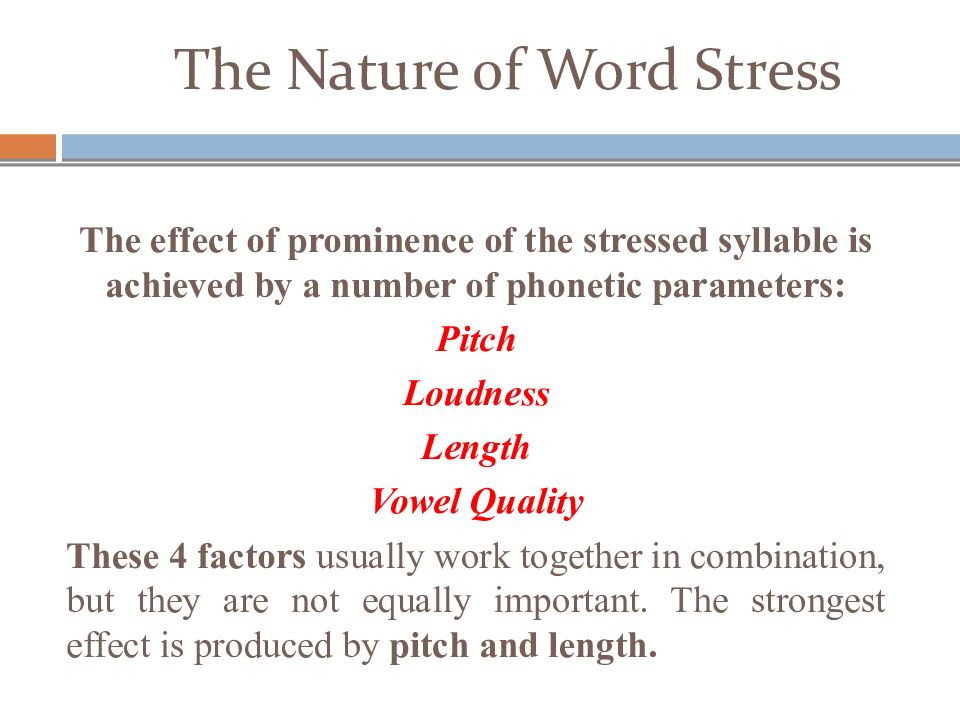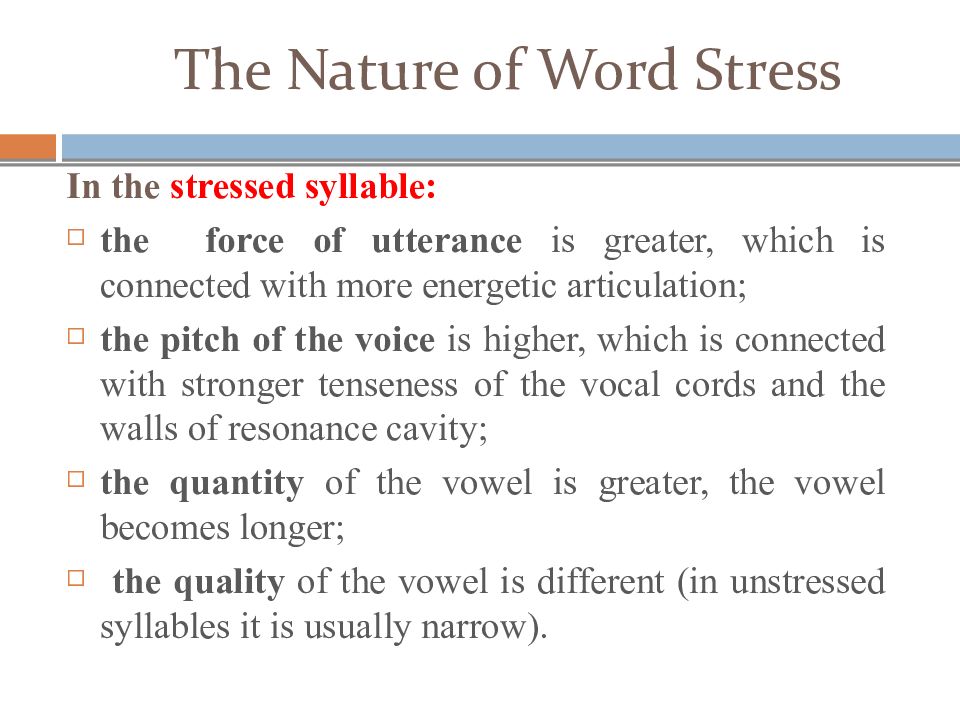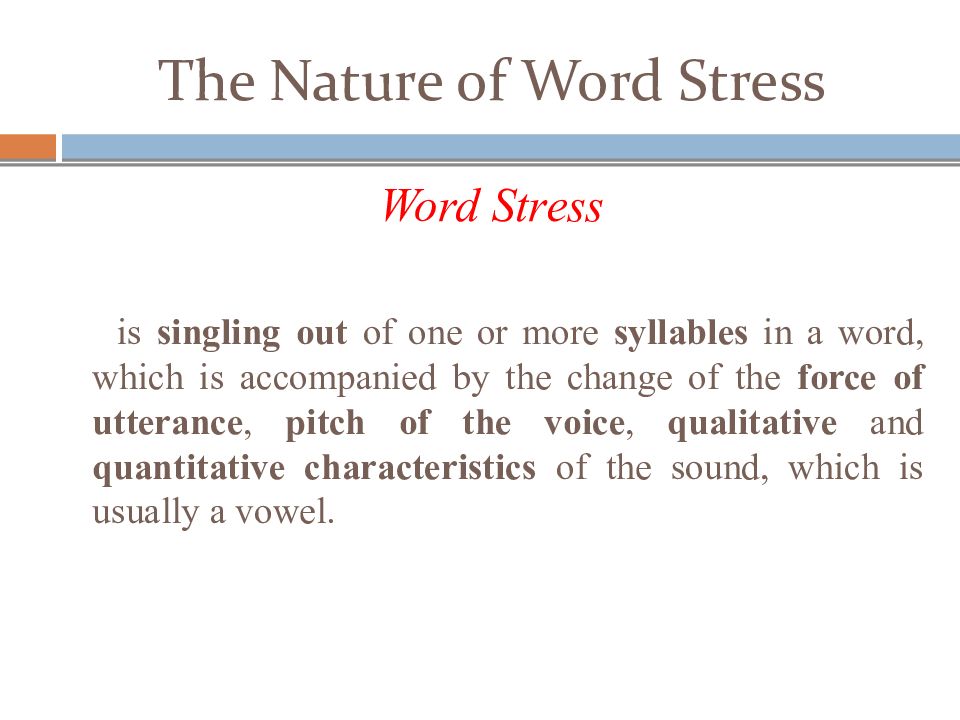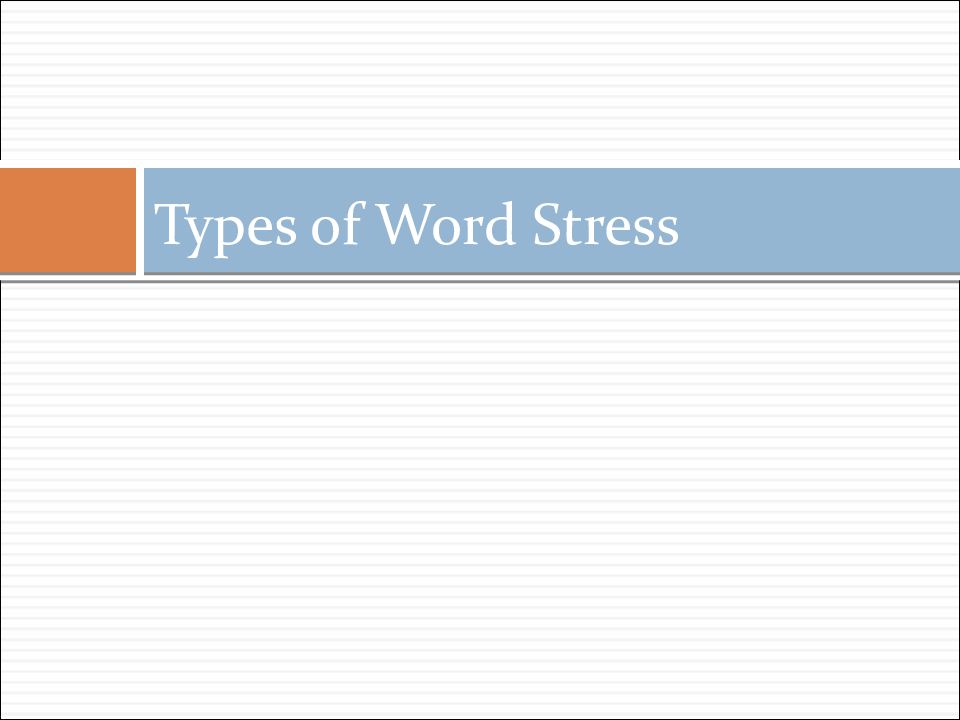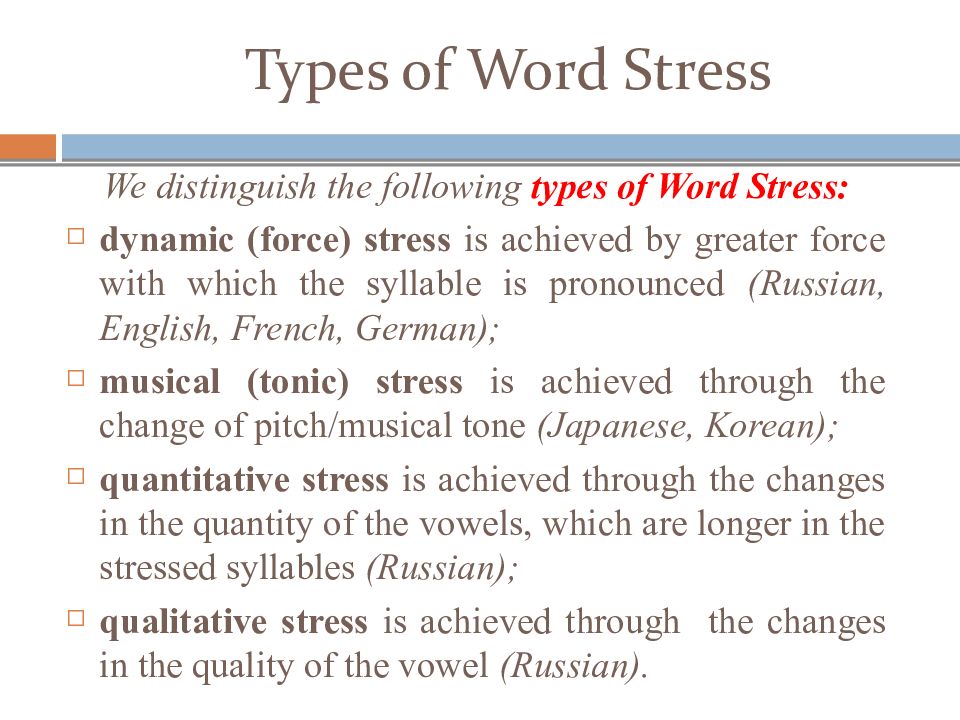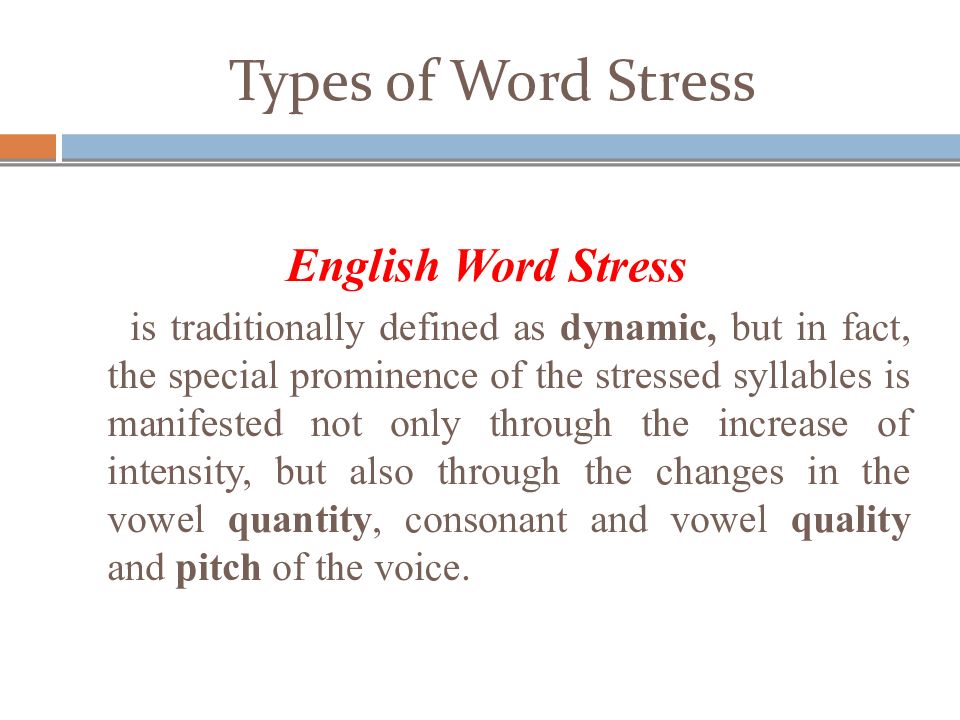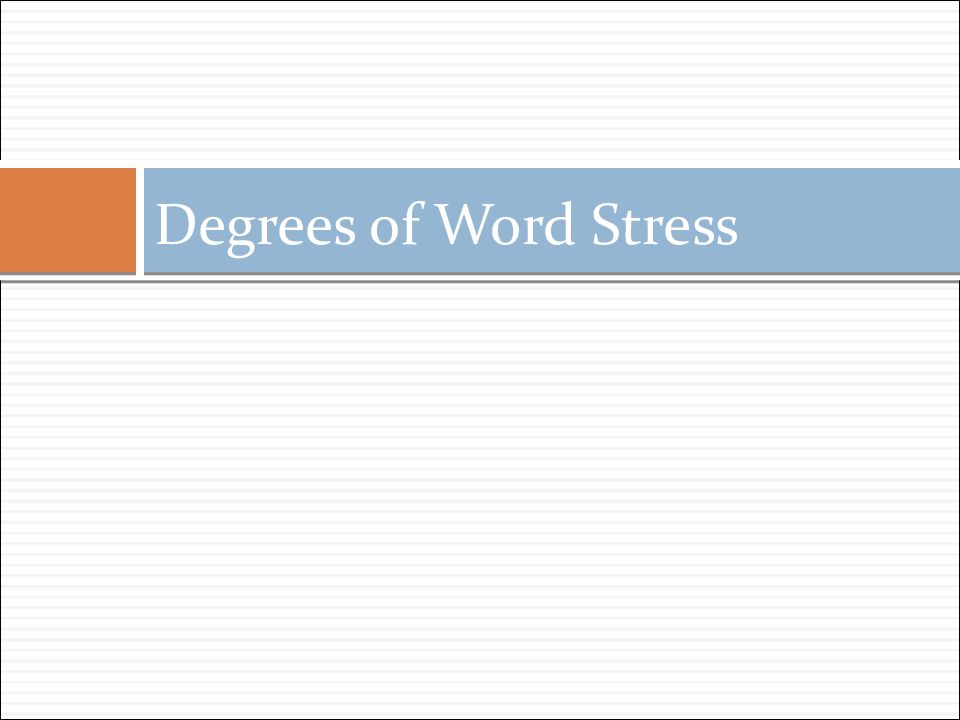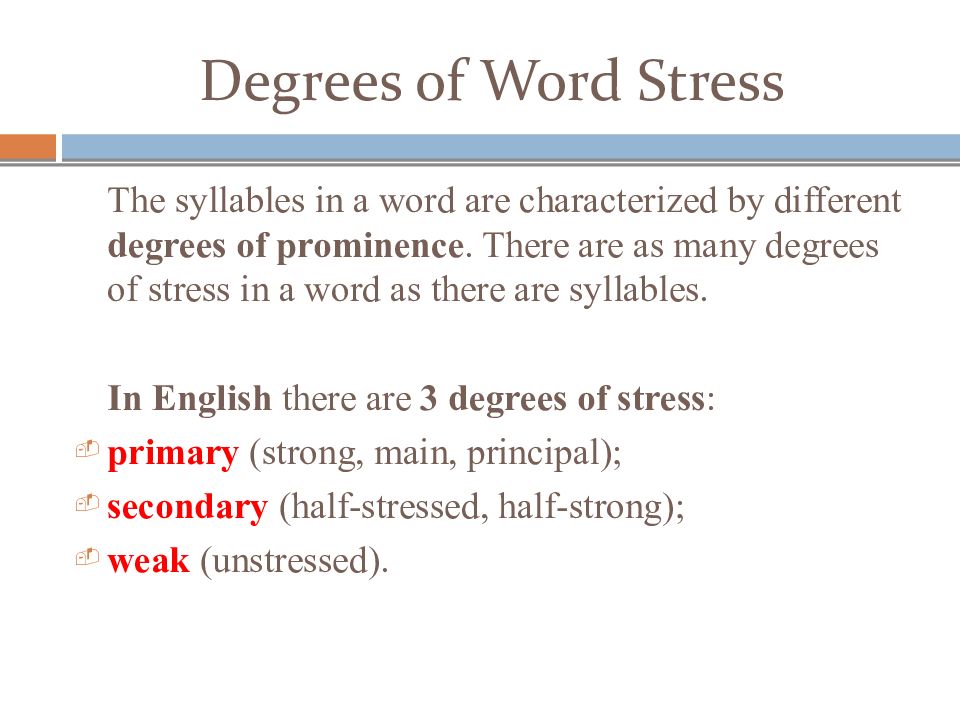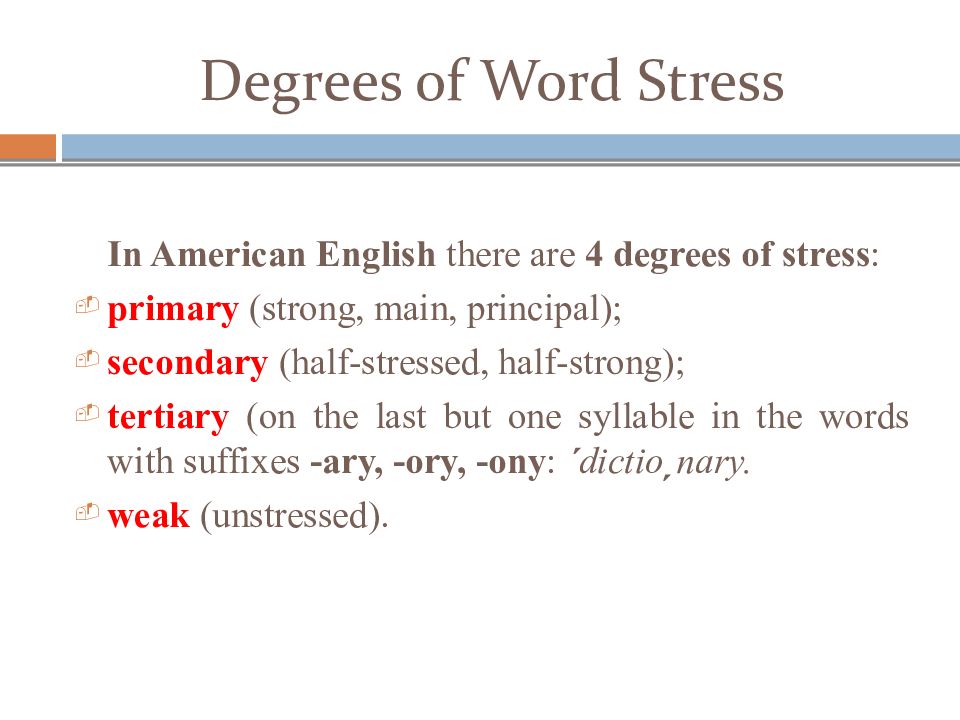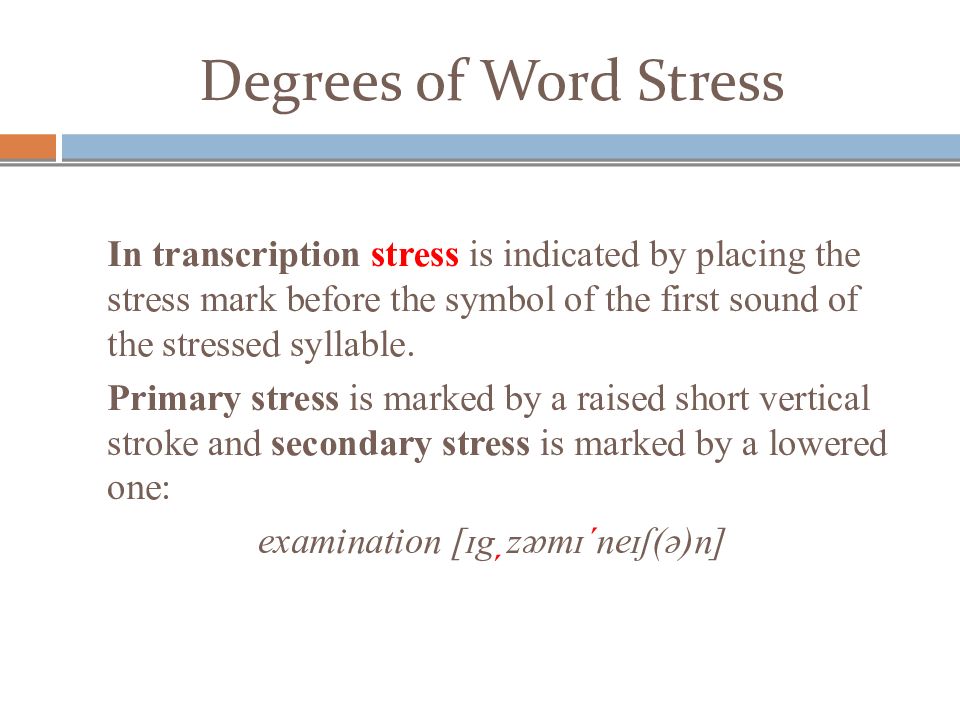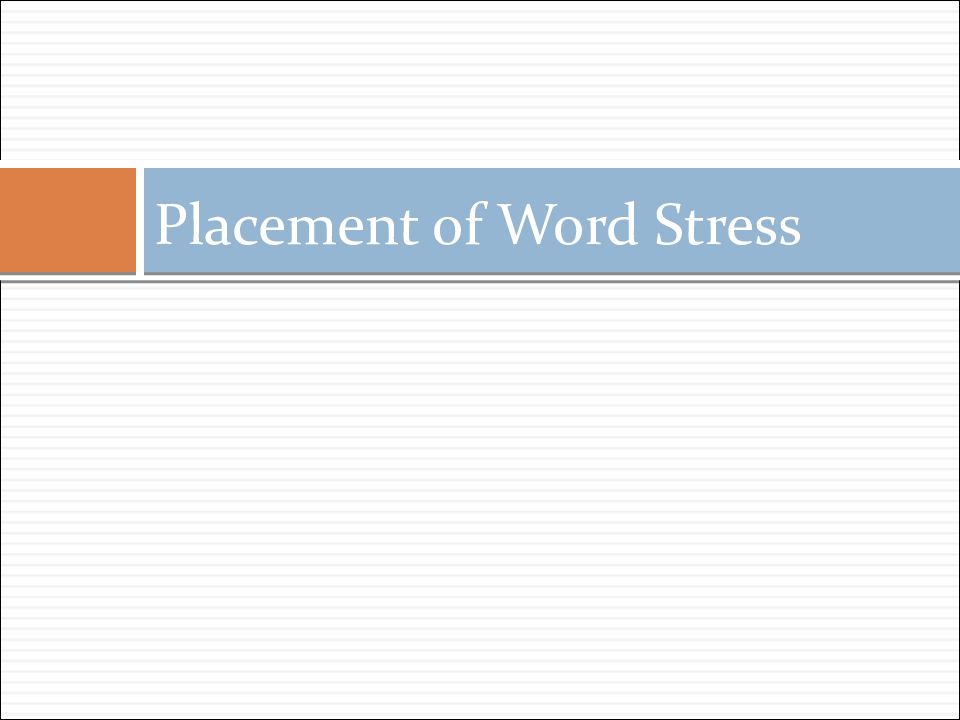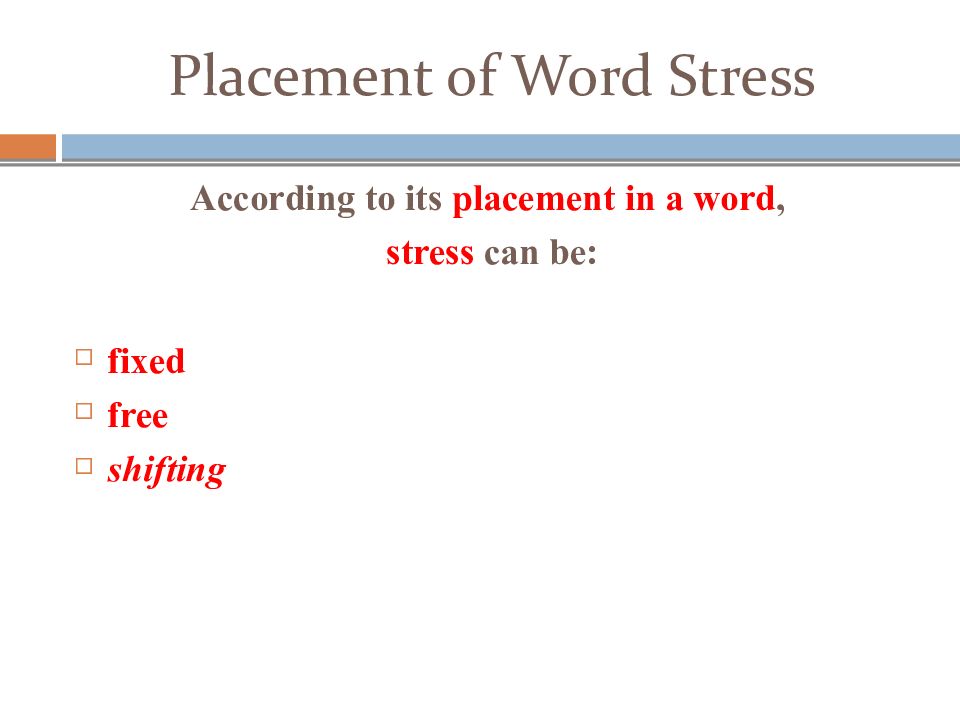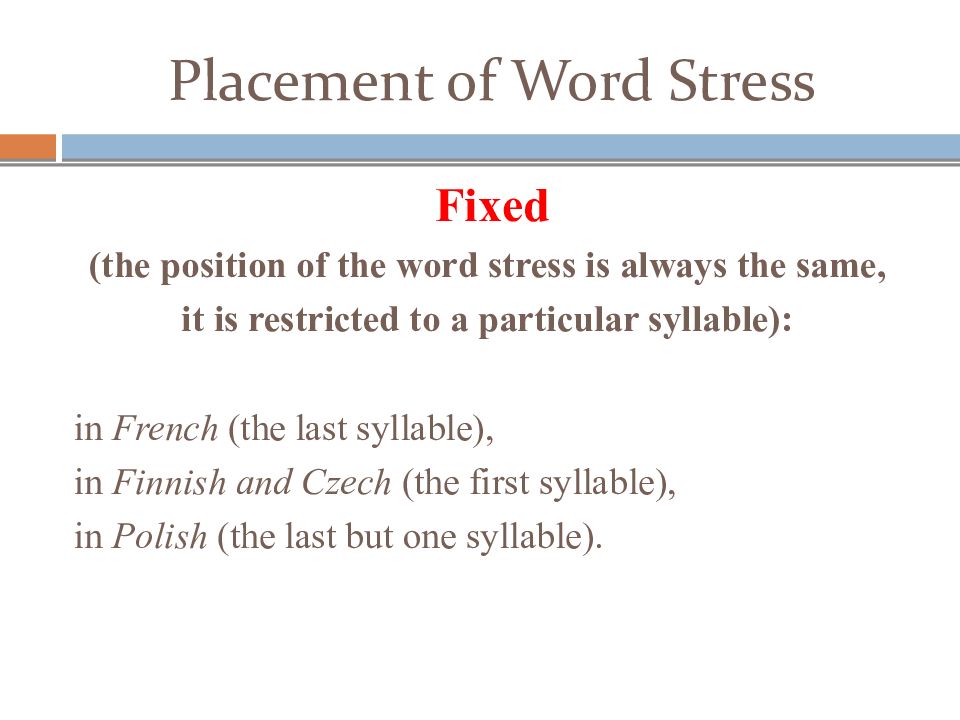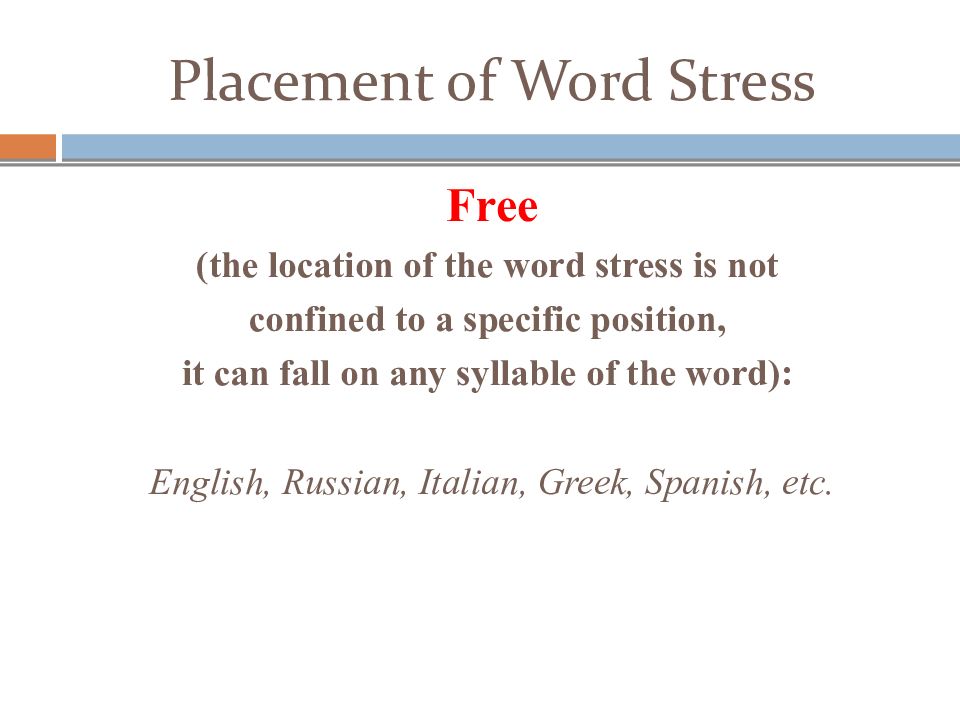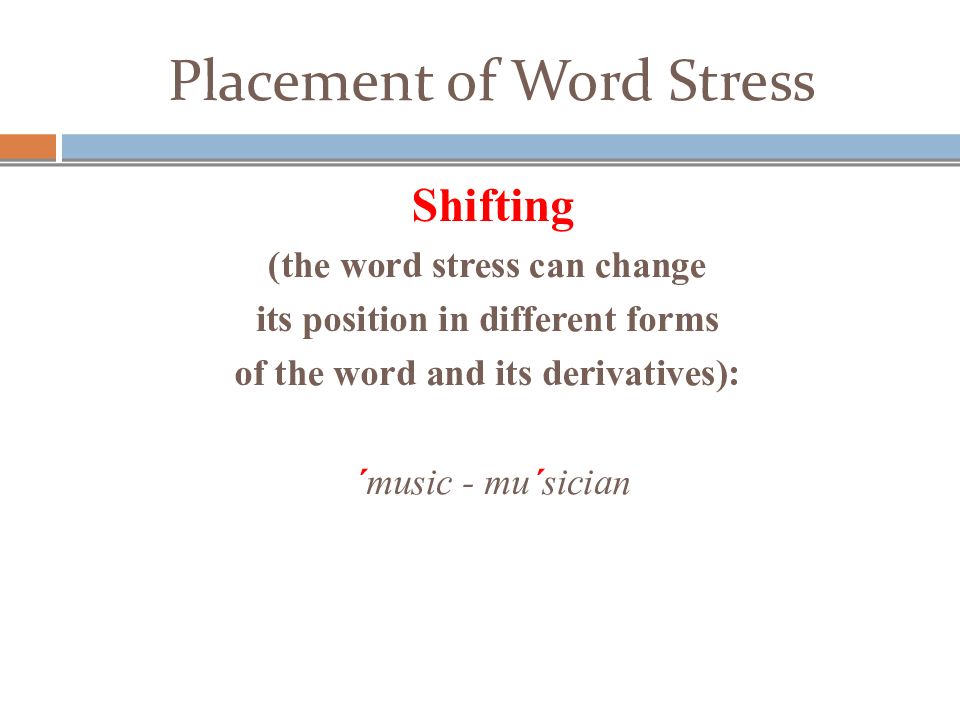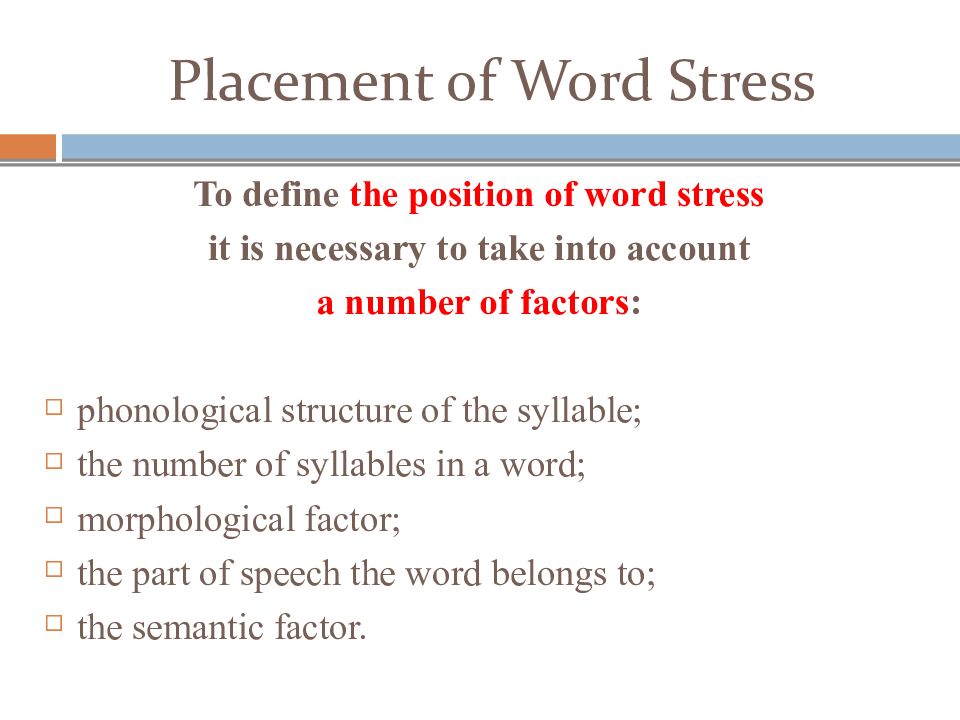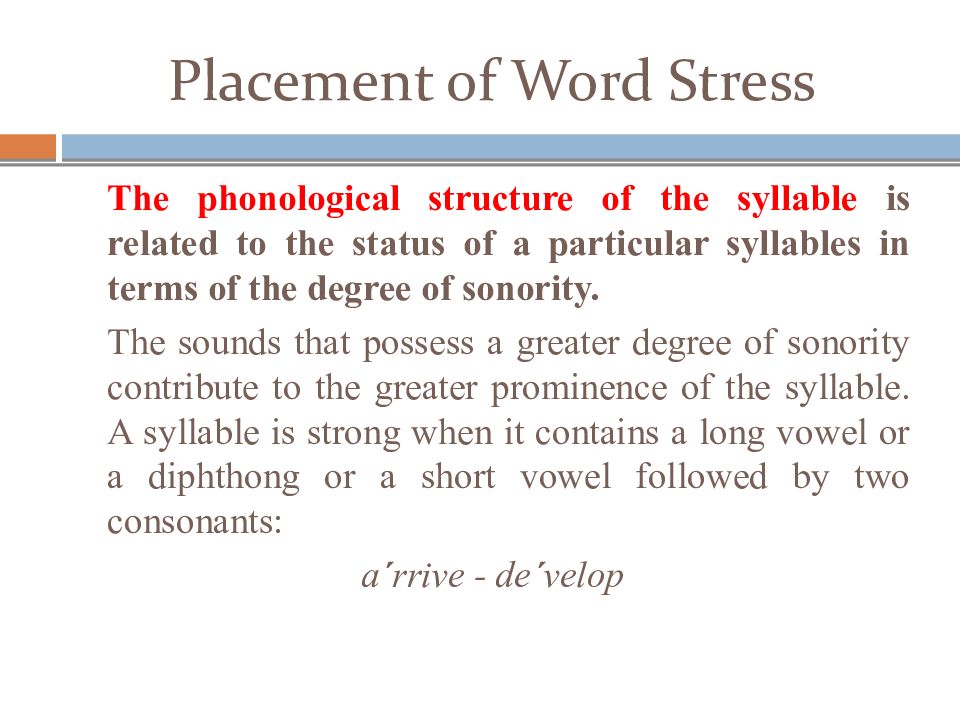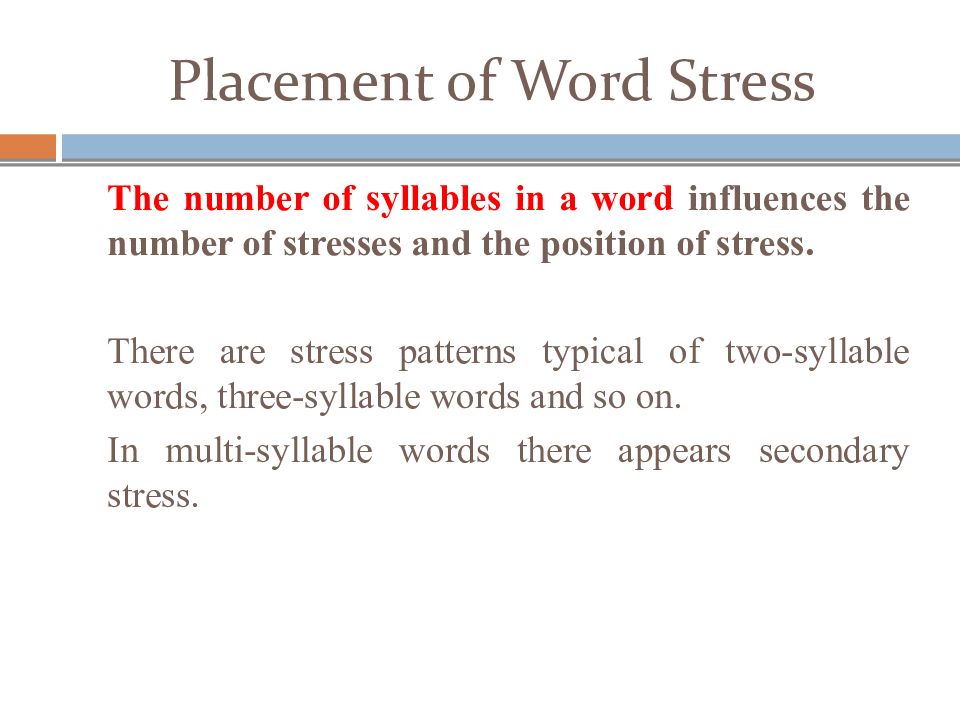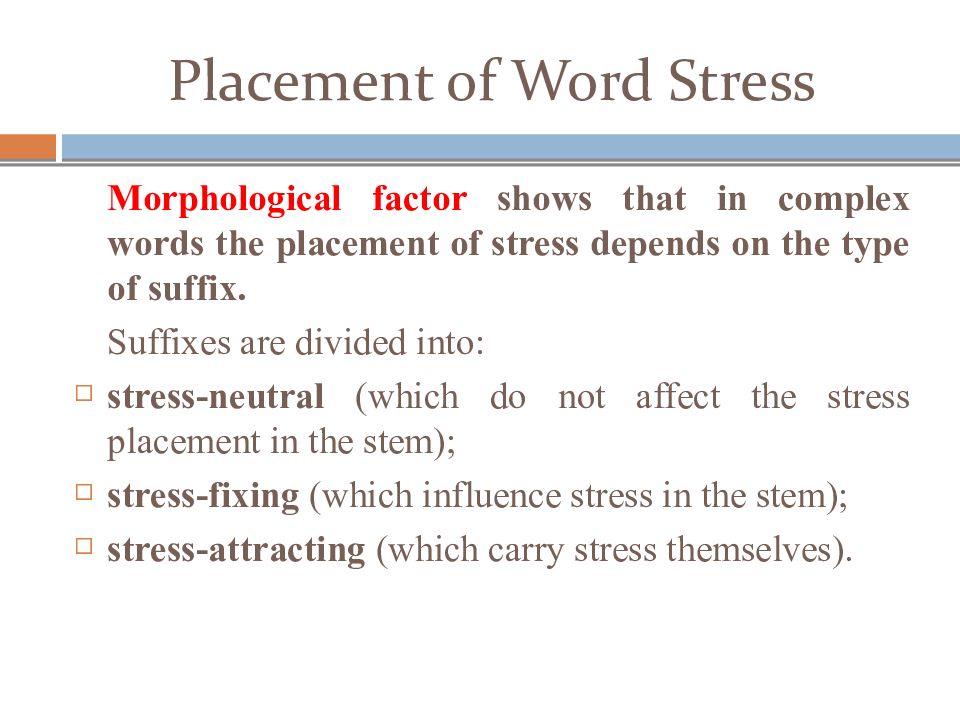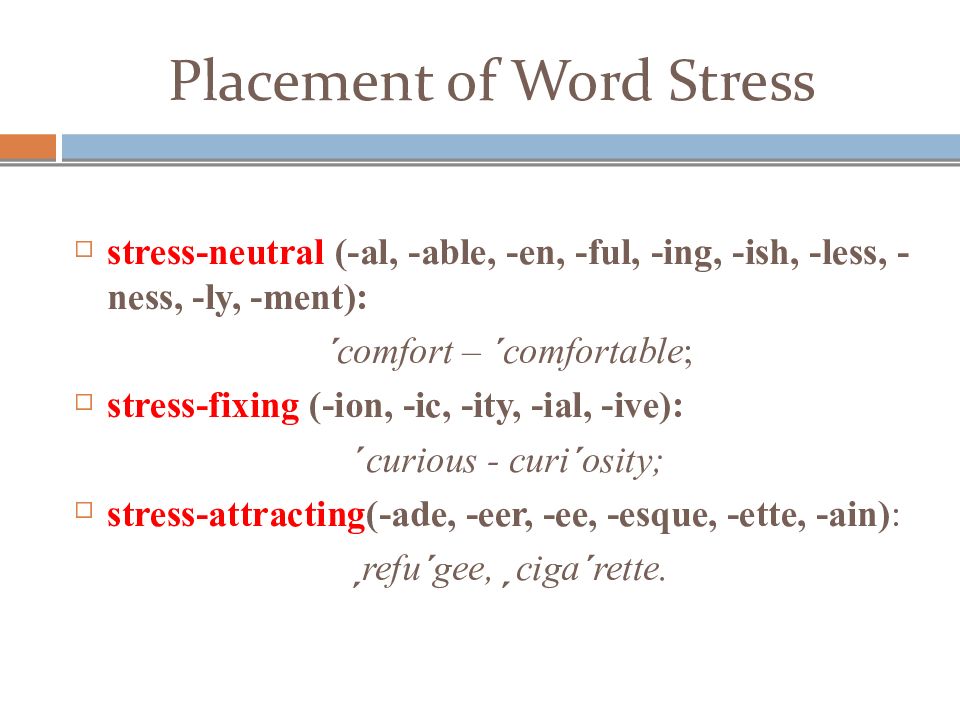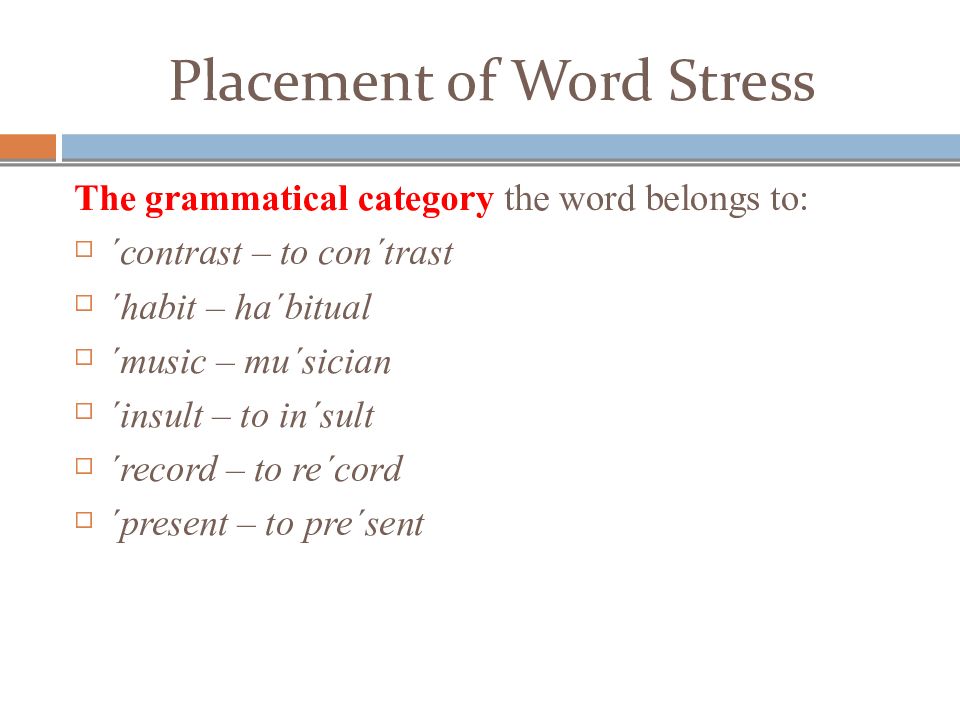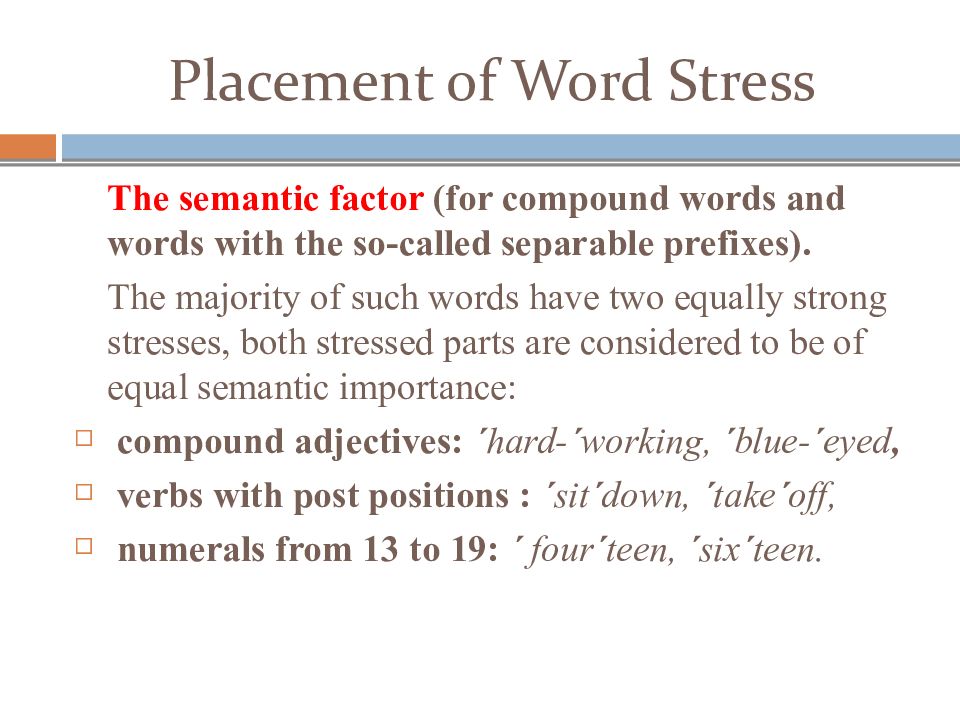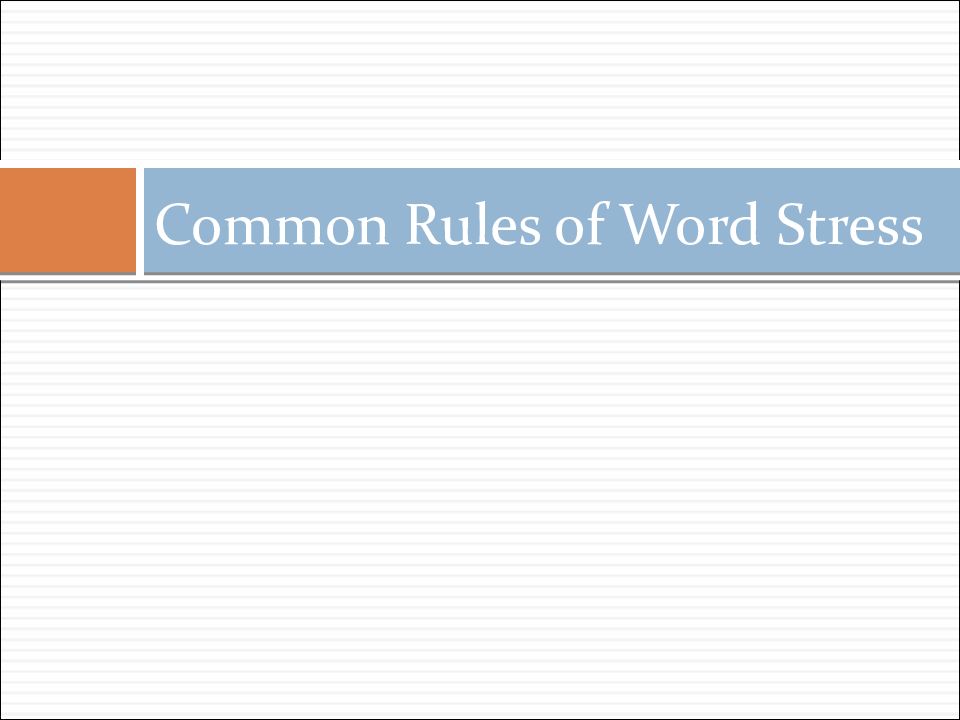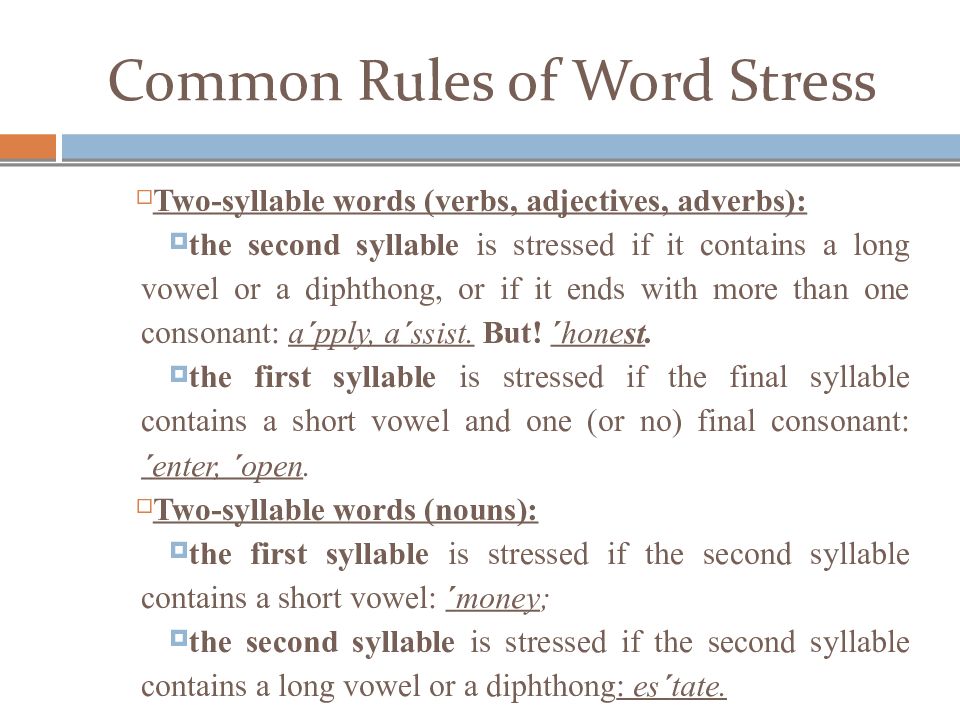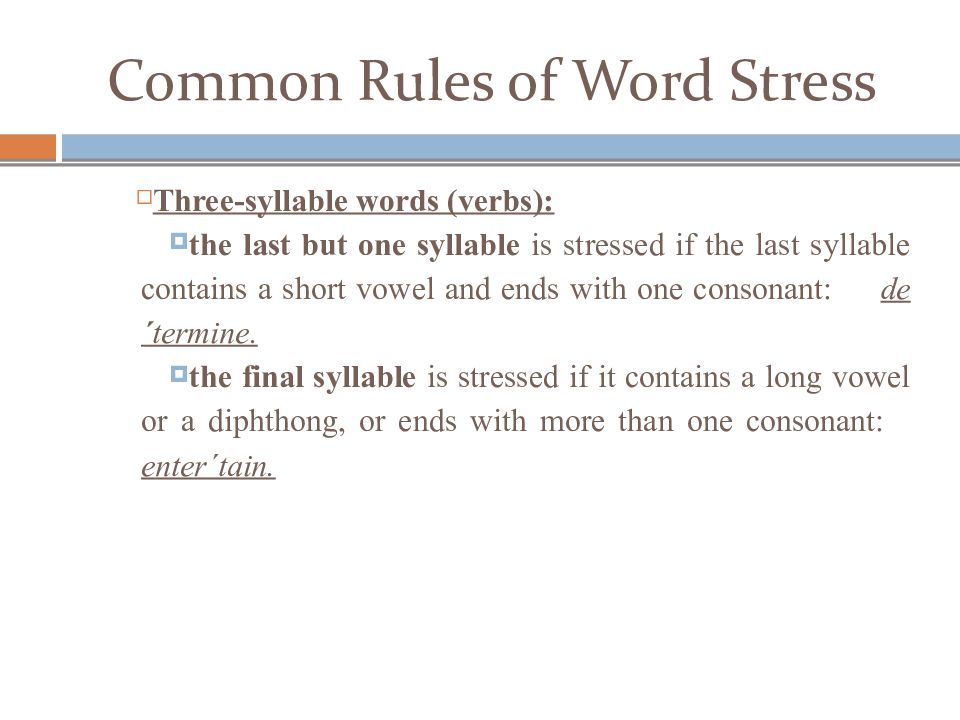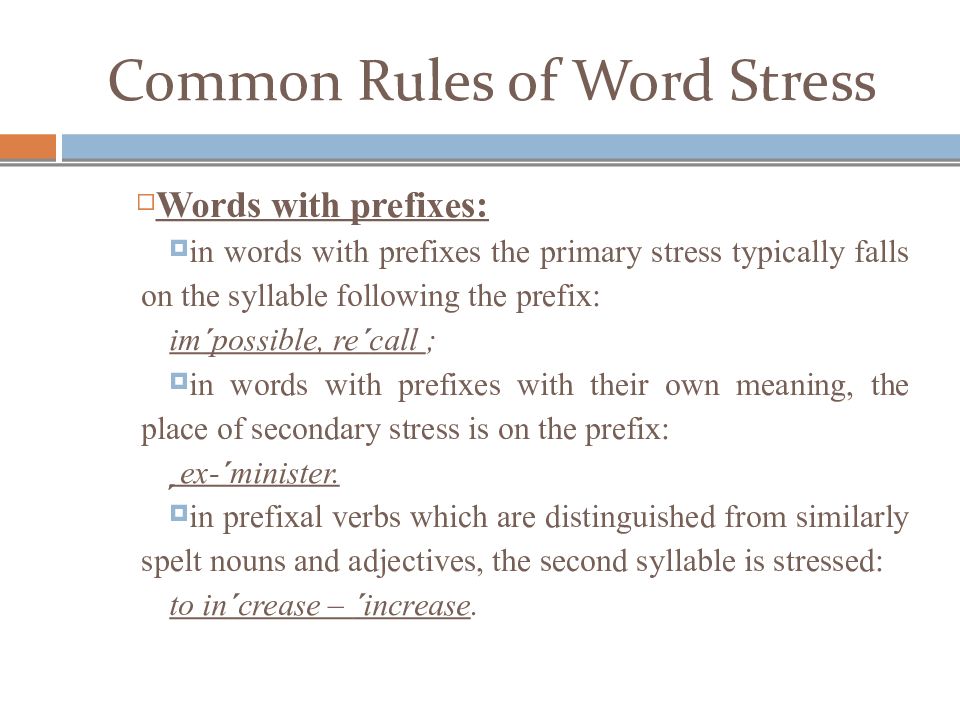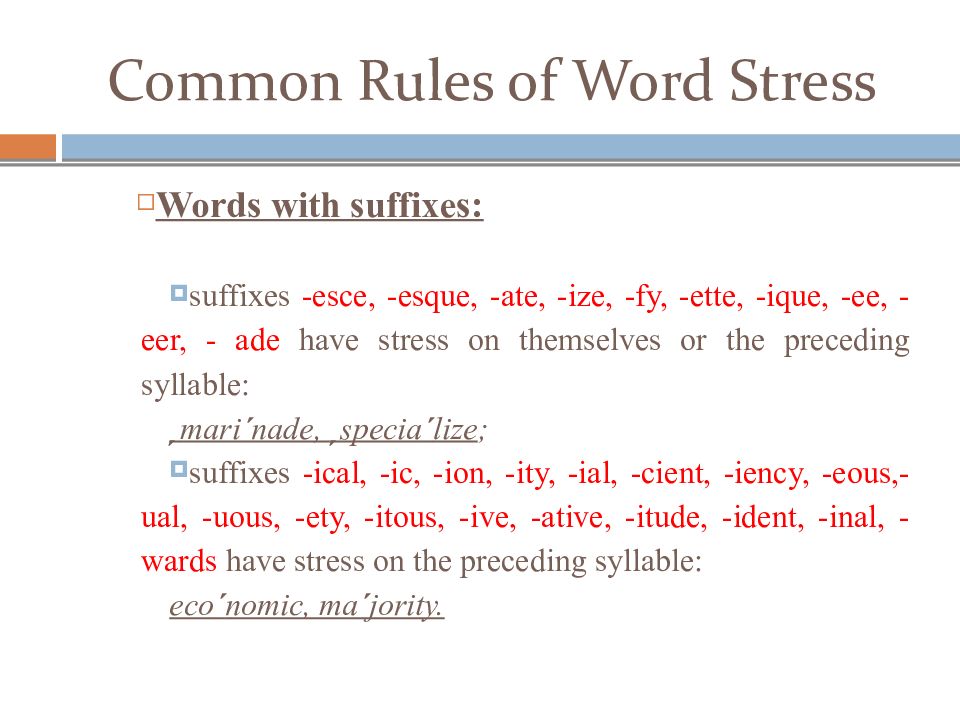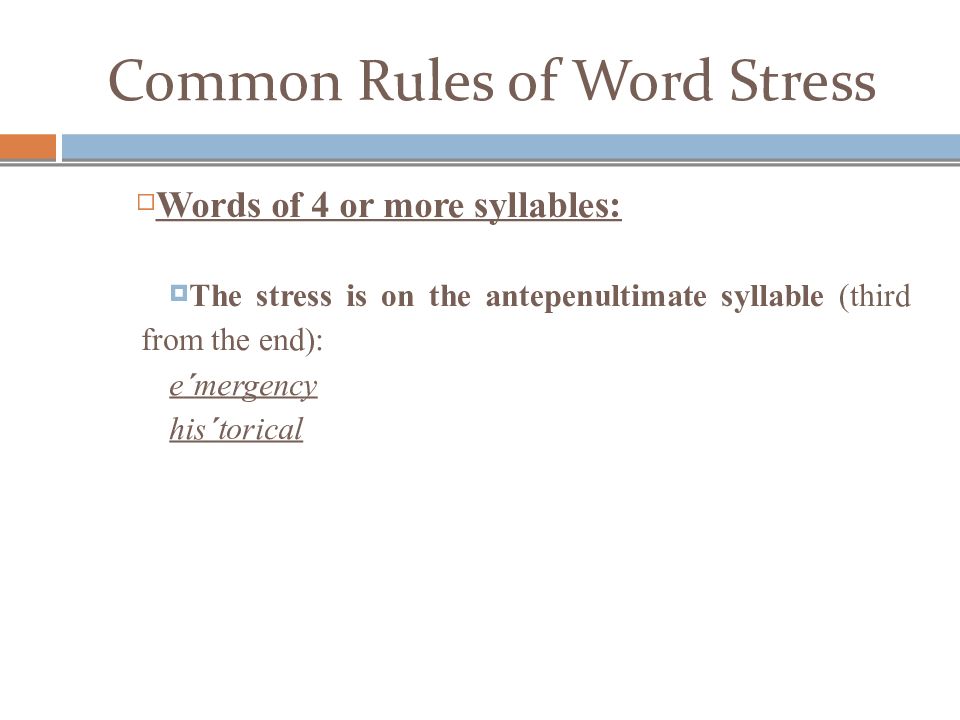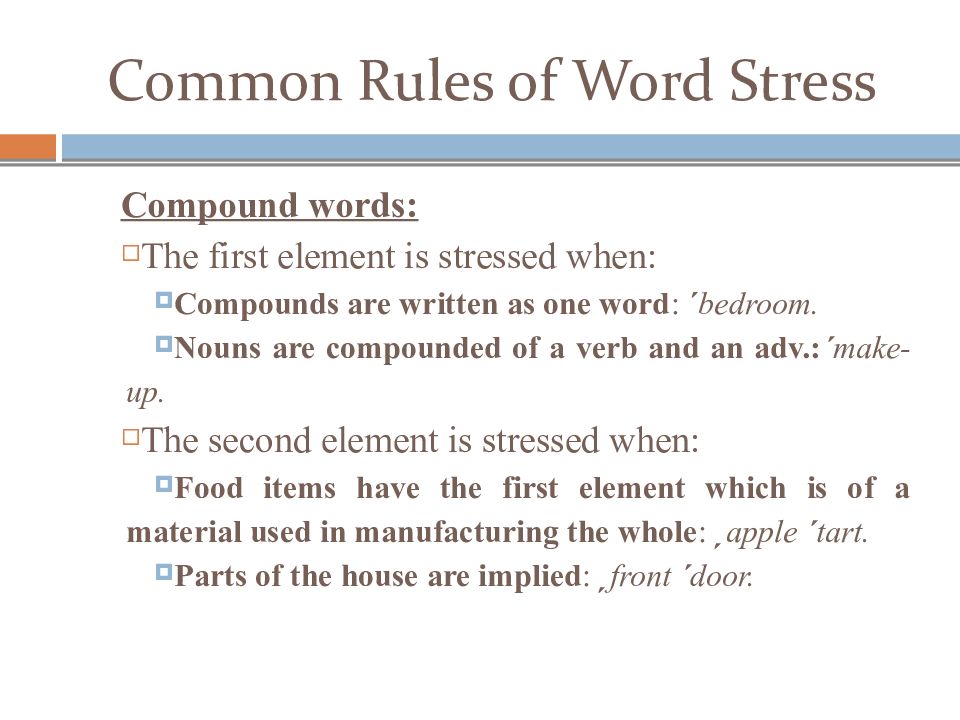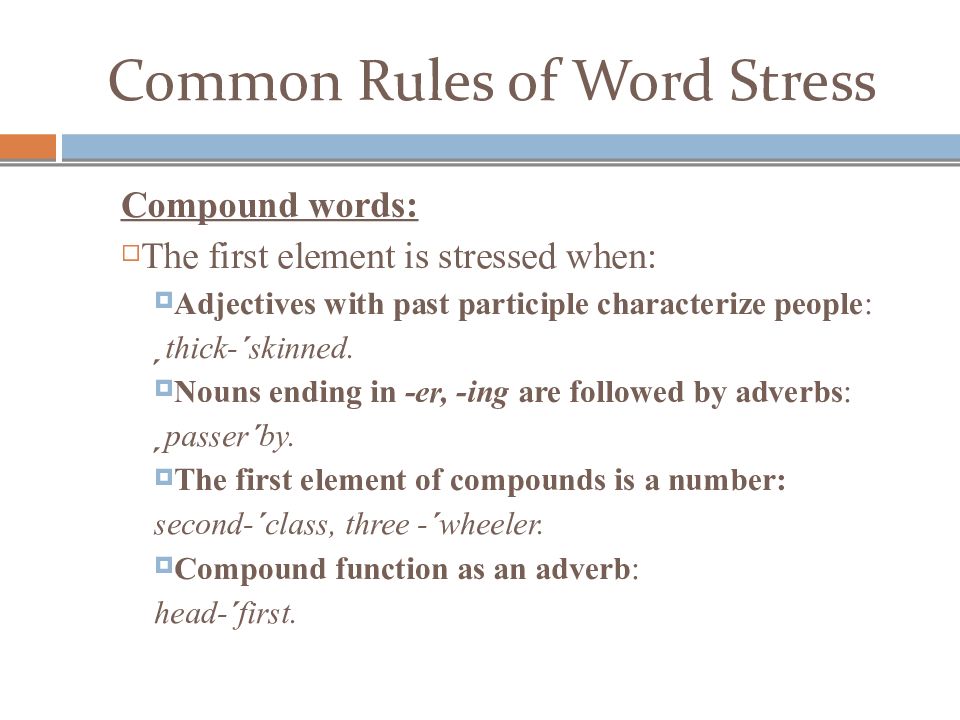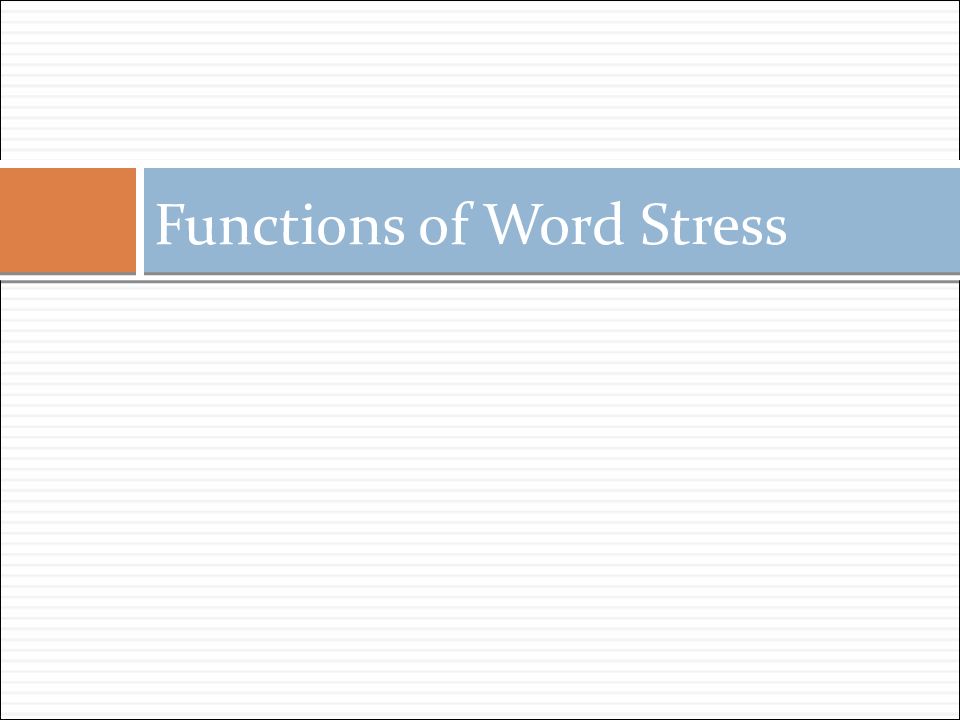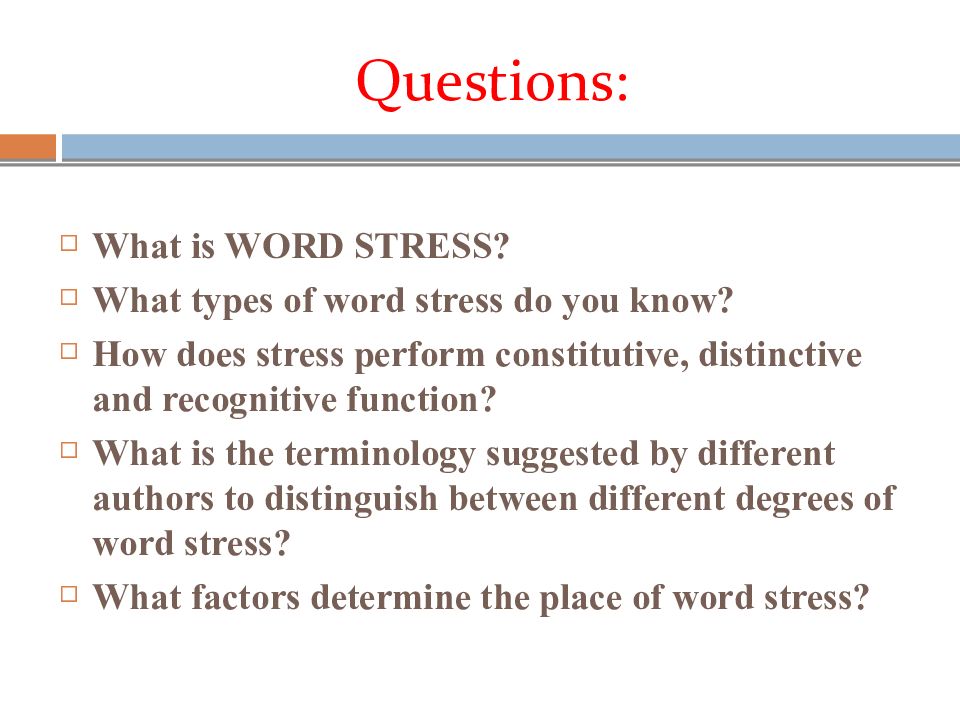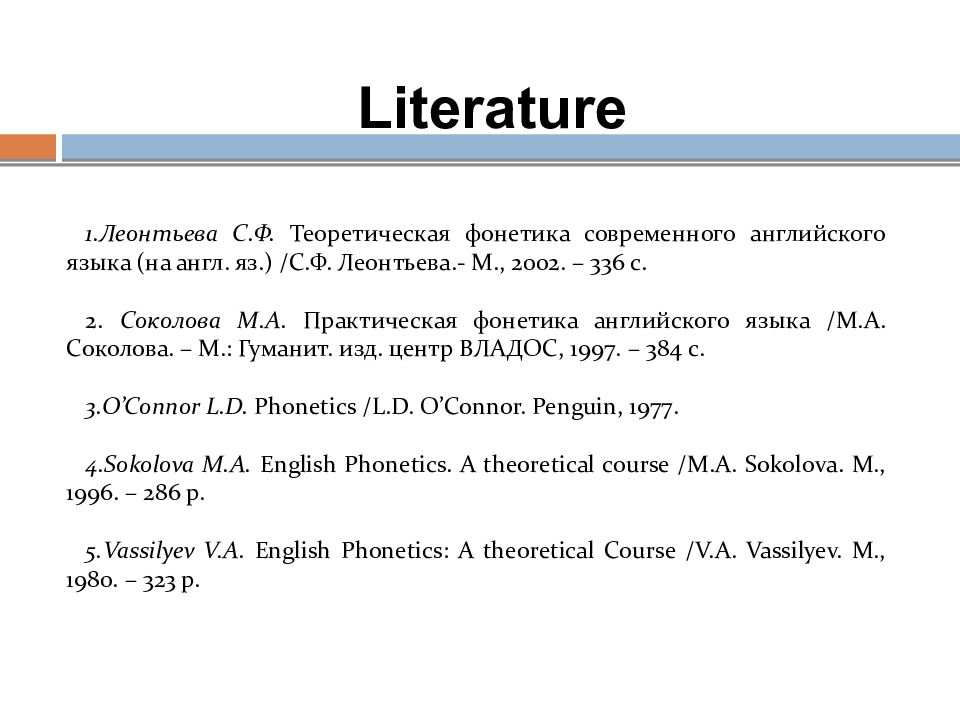-
Word stress, its acoustic
nature. -
The
linguistic function of a word stress. -
Degree
and position of a word stress.
-1-
The
sequence of syllables in the word is not pronounced identically. The
syllable or syllables which are pronounced with more prominence than
the other syllables of the word are said to be stressed or accented.
The correlation of varying prominences of syllables in a word is
understood as the accentual structure of the word.
According
to A.C. Gimson, the effect of prominence is achieved by any or all of
four factors: force, tone, length and vowel colour. The dynamic
stress implies greater force with which the syllable is pronounced.
In other words in the articulation of the stressed syllable greater
muscular energy is produced by the speaker. The European languages
such as English, German, French, Russian are believed to possess
predominantly dynamic word stress. In Scandinavian languages the word
stress is considered to be both dynamic and musical (e.g. in Swedish,
the word komma
(comma) is distinguished from the word komma
(come) by a difference in tones). The musical (tonic) word stress is
observed in Chinese, Japanese. It is effected by the variations of
the voice pitch in relation to neighbouring syllables. In Chinese the
sound sequence “chu” pronounced with the level tone means “pig”,
with the rising tone “bamboo”, and with the falling tone “to
live”.
It is fair
to mention that there is a terminological confusion in discussing the
nature of stress. According to D. Crystal, the terms “heaviness,
intensity, amplitude, prominence, emphasis, accent, stress” tend to
be used synonymously by most writers. The discrepancy in terminology
is largely due to the fact that there are 2 major views depending on
whether the productive or receptive aspects of stress are discussed.
The main
drawback with any theory of stress based on production of speech is
that it only gives a partial explanation of the phenomenon but does
not analyze it on the perceptive level.
Instrumental
investigations study the physical nature of word stress. On the
acoustic level the counterpart of force is the intensity of the
vibrations of the vocal cords of the speaker which is perceived by
the listener as loudness. Thus the greater energy with which the
speaker articulates the stressed syllable in the word is associated
by the listener with greater loudness. The acoustic counterparts of
voice pitch and length are frequency and duration respectively. The
nature of word stress in Russian seems to differ from that in
English. The quantitative component plays a greater role in Russian
accentual structure than in English word accent. In the Russian
language of full formation and full length in unstressed positions,
they are always reduced. Therefore the vowels of full length are
unmistakably perceived as stressed. In English the quantitative
component of word stress is not of primary importance because of the
non-reduced vowels in the unstressed syllables which sometimes occur
in English words (e.g. “transport”, “architect”).
-2-
In discussing accentual
structure of English words we should turn now to the functional
aspect of word stress. In language the word stress performs 3
functions:
-
constitutive– word
stress constitutes a word, it organizes the syllables of a word into
a language unit. A word does not exist without the word stress. Thus
the function is constitutive – sound continuum becomes a phrase
when it is divided into units organized by word stress into words. -
Word
stress enables a person to identify a succession of syllables as a
definite accentual pattern of a word. This function is known as
identificatory (or
recognitive). -
Word
stress alone is capable of differentiating the meaning of words or
their forms, thus performing its distinctive
function. The accentual patterns of
words or the degrees of word stress and their positions form
oppositions (“/import – im /port”, “/present – pre
/sent”).
-3-
There are
actually as many degrees of word stress in a word as there are
syllables. The British linguists usually distinguish three degrees of
stress in the word. The primary stress is the strongest (e.g.
exami/nation), the secondary stress is the second strongest one (e.g.
ex,ami/nation). All the other degrees are termed “weak stress”.
Unstressed syllables are supposed to have weak stress. The American
scholars, B. Bloch and J. Trager, find 4 contrastive degrees
of word stress: locid, reduced locid, medial and weak.
In
Germanic languages the word stress originally fell on the initial
syllable or the second syllable, the root syllable in the English
words with prefixes. This tendency was called recessive. Most English
words of Anglo-Saxon origin as well as the French borrowings are
subjected to this recessive tendency.
Languages
are also differentiated according to the placement of word stress.
The traditional classification of languages concerning the place of
stress in a word is into those with a
fixed stress and a free stress. In
languages with a fixed stress the occurrence of the word stress is
limited to a particular syllable in a multisyllabic word. For
example, in French the stress falls on the last syllable of the word
(if pronounced in isolation), in Finnish and Czech it is fixed on the
first syllable.
Some
borrowed words retain their stress.
In languages with a free
stress its place is not confined to a specific position in the word.
The free placement of stress is exemplified in the English and
Russian languages
(e.g. E. appetite – begin –
examination
R.
озеро – погода
– молоко)
The word
stress in English as well as in Russian is not only free but it may
also be shifting performing semantic function of differentiating
lexical units, parts of speech, grammatical forms. It is worth noting
that in English word stress is used as a means of word-building (e.g.
/contrast – con/trast, /music – mu /sician).
Questions:
-
What
features characterize word accent? -
Identify
the functions of word stress. -
What
are the types of word stress? -
Do AmE and
BE have any differences in the system of word stress? Give your
examples.
Lecture 8. Intonation
-
Intonation.
-
The
linguistic function of intonation. -
The
implications of a terminal tone. -
Rhythm.
-1-
Intonation is a language
universal. There are no languages which are spoken as a monotone,
i.e. without any change of prosodic parametres. On perceptional level
intonation is a complex, a whole, formed by significant variations of
pitch, loudness and tempo closely related. Some linguists regard
speech timber as the fourth component of intonation. Though it
certainly conveys some shades of attitudinal or emotional meaning
there’s no reason to consider it alongside with the 3
prosodic components of intonation (pitch, loudness and tempo).
Nowadays the term “prosody” substitutes the term “intonation”.
On the acoustic level pitch
correlates with the fundamental frequency of the vibrations of the
vocal cords; loudness correlates with the amplitude of vibrations;
tempo is a correlate of time during which a speech unit lasts.
The auditory level is very
important for teachers of foreign languages. Each syllable of the
speech chain has a special pitch colouring. Some of the syllables
have significant moves of tone up and down. Each syllable bears a
definite amount of loudness. Pitch movements are inseparably
connected with loudness. Together with the tempo of speech they form
an intonation pattern which is the basic unit of intonation.
An intonation pattern contains
one nucleus and may contain other stressed or unstressed syllables
normally preceding or following the nucleus. The boundaries of an
intonation pattern may be marked by stops of phonation, that is
temporal pauses.
Intonation patterns serve to
actualize syntagms in oral speech. The syntagm
is a group of words which are semantically and syntactically
complete. In phonetics they are called intonation
groups. The
intonation group is a stretch of speech which may have the length of
the whole phrase. But the phrase often contains more than one
intonation group. The number of them depends on the length of phrase
and the degree of semantic impotence or emphasis given to various
parts of it. The position of intonation groups may affect the
meaning.
-2-
The communicative
function of
intonation is realized in various ways which can be grouped under
five – six general headings:
-
to
structure the intonation content of a textual unit. So as to show
which information is new or can not be taken for granted, as against
information which the listener is assumed to possess or to be able
to acquire from the context, that is given information; -
to
determine the speech function of a phrase, to indicate whether it is
intended as a statement, question, etc; -
to
convey connotational meanings of attitude, such as surprise, etc. In
the written form we are given only the lexics and the grammar; -
to
structure a text. Intonation is an organizing mechanism. It divides
texts into smaller parts and on the other hand it integrates them
forming a complete text; -
to
differentiate the meaning of textual units of the same phonetic
structure and the same lexical composition (distinctive or
phonological function); -
to
characterize a particular style or variety of oral speech which may
be called a stylistic function.
-3-
Classification of intonation
patterns:
Different combinations of
pitch sections (pre-heads, heads and nuclei) may result in more than
one hundred pitch-and-stress patterns. But it is not necessary to
deal with all of them, because some patterns occur very rarely. So,
attention must be concentrated on the commonest ones:
-
The Low (Medium) Fall
pitch-and-stress group -
The
High Fall group -
Rise
Fall group -
The
Low Rise group -
The
High Rise group -
The
Fall Rise group -
The
Rise-Fall-Rise group -
The
Mid-level group
No intonation pattern is used
exclusively with this or that sentence type. Some sentences are more
likely to be said with one intonation pattern than with any other. So
we can speak about “common intonation” for a particular type of
sentence.
-
Statements are most widely
used with the Low Fall preceded by the Falling or the High level
Head. They are final, complete and definite. -
Commands,
with the Low Fall are very powerful, intense, serious and strong. -
Exclamations
are very common with the High Fall.
-4-
We cannot fully describe
English intonation without reference to speech rhythm. Rhythm
seems to be a kind of framework of speech organization. Some
linguists consider it to be one of the components of intonation.
Rhythm is understood as
periodicity in time and space. We find it everywhere in life. Rhythm
as a linguistic notion is realized in lexical, syntactical and
prosodic means and mostly in their combinations.
In speech,
the type of rhythm depends on the language. Linguists divide
languages into two groups:
-
syllable-timed(French, Spanish);
-
stress-timed(English, German, Russian).
In a
syllable-timed language the speaker gives an approximately equal
amount of time to each syllable, whether the syllable is stressed or
unstressed.
In a
stress-timed language the rhythm is based on a larger unit, than
syllable. Though the amount of time given on each syllable varies
considerably, the total time of uttering each rhythmic unit is
practically unchanged. The stressed syllables of a rhythmic unit form
peaks of prominence. They tend to be pronounced at regular intervals
no matter how many unstressed syllables are located between every 2
stressed ones. Thus the distribution of time within the rhythmic unit
is unequal.
Speech
rhythm is traditionally defined as recurrence of stressed syllables
at more or less equal intervals of time in a speech continuum.
Questions:
-
Name
the basic components of intonation. -
What
is the connection between pitch and tempo? -
What
for do we need different nuclear tones? -
Which
nuclei are the commonest?
Lecture
9. Territorial varieties of English pronunciation
-
Varieties
of language. -
English
variants.
-1-
The
varieties of the language are conditioned by language communities
ranging from small groups to nations. National
language is the language of a nation,
the standard of its form, the language of a nation’s literature.
The literary spoken form has its national
pronunciation standard. A “standard”
may be defined as a socially accepted variety of a language
established by a codified norm of correctness. It is generally
accepted that for the “English English” it is “Received
Pronunciation” or RP; for the “American English” – “General
American pronunciation”; for the Australian English – “Educated
Australian”.
Though
every national variant of English has considerable differences in
pronunciation, lexics and grammar, they all have much in common which
gives us ground to speak of one and the same language – the English
language.
Every
national variety of the language falls into territorial
or regional dialects. Dialects are
distinguished from each other by differences in pronunciation,
grammar and vocabulary. When we refer to varieties in pronunciation
only, we use the word “accent”.
The social
differentiation of language is closely connected with the social
differentiation of society. Every language community, ranging from a
small group to a nation has its own social
dialect, and consequently, its own
social accent.
The
“language situation” may be spoken about in terms of the
horizontal and vertical differentiations of the language, the first
in accordance with the sphere of social activity, the second – with
its situational variability. Situational varieties of the language
are called functional dialects or functional styles and situational
pronunciation varieties – situational accents or phonostyles.
-2-
Nowadays
two main types of English are spoken in the English-speaking world:
English English and American English.
According to British
dialectologists (P. Trudgill, J. Hannah, A. Hughes and others) the
following variants of English are referred to the English-based
group: English English, Welsh English, Australian English, New
Zealand English; to the American-based group: United States English,
Canadian English.
Scottish English and Irish
English fall somewhere between the two being somewhat by themselves.
Соседние файлы в предмете [НЕСОРТИРОВАННОЕ]
- #
- #
- #
- #
- #
- #
- #
- #
- #
- #
- #
Скачать материал

Скачать материал


- Сейчас обучается 268 человек из 64 регионов






Описание презентации по отдельным слайдам:
-
1 слайд
Lecture 5. Word Stress
The Nature of Word Stress.
The Place of Word Stress in English. The Degrees of Stress.
The Functions and Tendencies of the English Stress.
The Typology of Accentual Structures. -
2 слайд
The syllable or syllables which are uttered with more prominence than the other syllables of the word are said to be stressed or accented.
Stress in the isolated word is termed word stress; stress in connected speech is termed sentence stress.
-
3 слайд
Word stress can be defined as the singling out of one or more syllables in a word, which is accompanied by the change of the force of utterance, pitch of the voice, qualitative and quantitative characteristics of the sound, which is usually a vowel.
In different languages one of the factors constituting word stress is usually more significant than the others. -
4 слайд
If special prominence in a stressed syllable or syllables is achieved mainly through the intensity of articulation, such type of stress is called dynamic, or force stress.
-
5 слайд
If special prominence in a stressed syllable is achieved mainly through the change of pitch, or musical tone, such accent is called musical, or tonic. It is characteristic of the Japanese, Korean and other oriental languages.
-
6 слайд
If special prominence in a stressed syllable is achieved through the changes in the quantity of the vowels, which are longer in the stressed syllables than in the unstressed ones, such type of stress is called quantitative.
Qualitative type of stress is achieved through the changes in the quality of the vowel under stress.
-
7 слайд
The traditional classification of languages concerning place of stress in a word is into those with a fixed stress and those with a free stress.
In languages with a fixed stress the occurrence of the word stress is limited to a particular syllable in a polysyllabic word.
In languages with a free stress its place is not confined to a specific position in the word.
E.g. ‘appetite — be’ginning — ba’lloon -
8 слайд
The word stress in English is not only free but it may also be shifting, performing the semantic function of differentiating lexical units, parts of speech, grammatical forms.
E.g. ‘contrast — con’trast; ‘music — mu’sician. -
9 слайд
There are actually as many degrees of stress in a word as there are syllables.
examination
ɪɡ.ˌzæm.ɪ.ˈneɪʃ. Ən
3 2 4 1 5Degrees of Word Stress
-
10 слайд
The primary stress is the strongest, it is marked by number 1, the secondary stress is the second strongest marked by 2. All the other degrees are termed weak stress. Unstressed syllables are supposed to have weak stress.
-
11 слайд
American linguists distinguish four degrees of word stress and term them: primary stress, secondary stress, tertiary stress and weak stress. The difference between the secondary and tertiary stresses is very subtle and seems subjective.
-
12 слайд
The second pretonic syllables of such words as libe’ration, recog’nition are marked by secondary stress in BrE, in AmE they are said to have tertiary stress.
In AmE tertiary stress also affects the suffixes -ory, -ary, -ony of nouns and the suffixes –ate, -ize, -y of verbs, which are considered unstressed in BrE, e.g. ‘territory, ‘ceremony, ‘dictionary; ‘demonstrate, ‘organize, ‘simplify.
-
13 слайд
Word stress in a language performs three functions.
Functions of Word Stress -
14 слайд
Word stress constitutes a word, it organizes the syllables of a word into a language unit having a definite accentual structure, that is a pattern of relationship among the syllables; a word does not exist without the word stress.
Constitutive function -
15 слайд
Word stress enables a person to identify a succession of syllables as a definite accentual pattern of a word.
Identificatory / recognitive function -
16 слайд
Word stress alone is capable of differentiating the meaning of words or their forms.
The accentual patterns of words or the degrees of word stress and their positions form oppositions:
E.g. ‘import — im’port, ‘billow — be’low.
Distinctive / contrastive function -
17 слайд
According to Prof. V.O. Vasyliev (V.A.Vassilyev), the distinctive function makes word accent a suprasegmental phonological unit which performs a sense-differentiating function. He calls it accenteme.
-
18 слайд
According to Prof. V.O. Vasyliev (V.A. Vassilyev), they are:
The recessive tendency
The rhythmic tendency
The retentive tendency
The semantic factor
Word Stress Tendencies
-
19 слайд
In Germanic languages the word stress originally fell on the initial syllable or the second syllable, the root syllable in the English words with prefixes.
Unrestricted recessive tendency is observed in the native English words having no prefix, e.g. mother, daughter, brother, swallow, in assimilated French borrowings, e.g. reason, colour, restaurant.
Restricted recessive tendency marks English words with prefixes which have no referential meaning now, e.g. foresee, begin, withdraw, apart.The recessive tendency
-
20 слайд
The rhythm of alternating stressed and unstressed syllables gave birth to this tendency in the present-day English which caused the appearance of the secondary stress in the multisyllabic French borrowings, e.g. ˌrevo’lution, ˌorgani’sation, aˌssimi’lation, etc.
It also explains the placement of primary stress on the third syllable from the end in three- and four-syllable words, e.g. ‘cinema, ‘situate, ar’ticulate.The rhythmic tendency
-
21 слайд
A third tendency was traced in the instability of the accentual structure of English word stress: a derivative often retains the stress of the original or parent word,
E.g. ‘person — ‘personal — ˌperso’nality,
‘similar — as’similate,
recom’mend — recommen ‘dation.The retentive tendency
-
22 слайд
It determines the stress in compound words and words with so-called separable prefixes.
The majority of such words have two equally strong stresses, both stressed parts are considered to be of equal semantic importance, with semantic factor thus canceling the rhythmic tendency in word stressing, e.g.
Compound adjectives: hard-working, blue-eyed;
Verbs with postpositions: sit down, take off;
Numerals from 13 to 19: fourteen, sixteen.The semantic factor
-
23 слайд
G.P. Torsuyev classifies the accentual types according to the number of stressed syllables, their degree or character (the main and the secondary stress).
The most widely spread accentual types are:
1. [‘___]. This accentual type marks both simple and compound words. The accentual structures of this type may include two and more syllables, e.g. ‘father, ‘possibly, ‘mother-in-law, ‘gas-pipe.The Typology of Accentual Structure
-
24 слайд
2. [ ‘_ ‘_ ]. The accentual type is commonly realized in compound words, most of them are with separable prefixes, e.g. ‘radio-‘active, ‘re’write, ‘diso’bey.
3. [‘_ ˌ___]. The type is realized both in simple and compound words, very common among compound words, e.g. ‘hair-,dresser, ‘substructure.
-
25 слайд
4. [ˌ _’___]. The accentual type marks a great number of simple words and some compound words as well. In simple words the stresses fall onto:
the prefix and the root: ˌmaga’zine;
the root and the suffix: ˌhospi’tality;
the prefix and the suffix. -
26 слайд
The variability of the word accentual structure is multiplied in connected speech. The accentual structure of words may be altered under the influence of rhythm, e.g. An ‘unpolished ‘stone but: The ‘stone was un’polished.
The tempo of speech may influence the accentual pattern of words. With the quickening of the speed the carefulness of articulation is diminished, the vowels are reduced or elided, the secondary stress may be dropped, e.g. The ‘whole organi’zation of the ‘meeting was ‘faulty.
Найдите материал к любому уроку, указав свой предмет (категорию), класс, учебник и тему:
6 210 049 материалов в базе
- Выберите категорию:
- Выберите учебник и тему
- Выберите класс:
-
Тип материала:
-
Все материалы
-
Статьи
-
Научные работы
-
Видеоуроки
-
Презентации
-
Конспекты
-
Тесты
-
Рабочие программы
-
Другие методич. материалы
-
Найти материалы
Другие материалы
- 16.12.2020
- 140
- 0
- 25.11.2020
- 114
- 0
- 14.11.2020
- 119
- 0
- 09.11.2020
- 132
- 0
- 01.11.2020
- 116
- 0
- 21.10.2020
- 124
- 0
- 10.10.2020
- 91
- 0
- 17.09.2020
- 89
- 0
Вам будут интересны эти курсы:
-
Курс повышения квалификации «Правовое обеспечение деятельности коммерческой организации и индивидуальных предпринимателей»
-
Курс повышения квалификации «Формирование компетенций межкультурной коммуникации в условиях реализации ФГОС»
-
Курс повышения квалификации «Организация практики студентов в соответствии с требованиями ФГОС технических направлений подготовки»
-
Курс повышения квалификации «Разработка бизнес-плана и анализ инвестиционных проектов»
-
Курс повышения квалификации «Финансы: управление структурой капитала»
-
Курс повышения квалификации «Финансы предприятия: актуальные аспекты в оценке стоимости бизнеса»
-
Курс повышения квалификации «Методы и инструменты современного моделирования»
-
Курс профессиональной переподготовки «Уголовно-правовые дисциплины: теория и методика преподавания в образовательной организации»
-
Курс повышения квалификации «Финансовые инструменты»
-
Курс профессиональной переподготовки «Гостиничный менеджмент: организация управления текущей деятельностью»
-
Курс профессиональной переподготовки «Осуществление и координация продаж»
-
Курс профессиональной переподготовки «Управление качеством»
Слайды и текст этой презентации
Слайд 1
Описание слайда:
Word Stress
Lecture 5
Слайд 2
Описание слайда:
Plan
General Notes on Word Stress.
Types of Word Stress.
Degrees of Word Stress.
Placement of Word Stress.
Common Rules of Word Stress in English.
Functions of Word Stress.
Слайд 3
Описание слайда:
The Nature of Word Stress
Слайд 4
Описание слайда:
The Nature of Word Stress
Word Stress
is a greater degree of prominence of a syllable or syllables as compared to the other syllables of the word
Слайд 5
Описание слайда:
The Nature of Word Stress
Scientists about Word Stress:
D. Jones: Word Stress is the degree of force, which is accompanied by a strong force of exhalation and gives an impression of loudness.
A. C. Gimson: English word stress or accent is a complex phenomenon, marked by the variations in force, pitch, quality and quantity.
Слайд 6
Описание слайда:
The Nature of Word Stress
Scientists about Word Stress:
B. A. Bogoroditsky: Stress as an increase of energy, accompanied by an increase of expiratory and articulatory activity.
S. F. Leontyeva: Word stress can be defined as the singling out of one or more syllables in a word, which is accompanied by the change of the force of utterance, pitch of the voice, qualitative and quantitative characteristics of the sound which is usually a vowel.
Слайд 7
Описание слайда:
The Nature of Word Stress
The effect of prominence of the stressed syllable is achieved by a number of phonetic parameters:
Pitch
Loudness
Length
Vowel Quality
These 4 factors usually work together in combination, but they are not equally important. The strongest effect is produced by pitch and length.
Слайд 8
Описание слайда:
The Nature of Word Stress
In the stressed syllable:
the force of utterance is greater, which is connected with more energetic articulation;
the pitch of the voice is higher, which is connected with stronger tenseness of the vocal cords and the walls of resonance cavity;
the quantity of the vowel is greater, the vowel becomes longer;
the quality of the vowel is different (in unstressed syllables it is usually narrow).
Слайд 9
Описание слайда:
The Nature of Word Stress
Word Stress
is singling out of one or more syllables in a word, which is accompanied by the change of the force of utterance, pitch of the voice, qualitative and quantitative characteristics of the sound, which is usually a vowel.
Слайд 10
Описание слайда:
Types of Word Stress
Слайд 11
Описание слайда:
Types of Word Stress
We distinguish the following types of Word Stress:
dynamic (force) stress is achieved by greater force with which the syllable is pronounced (Russian, English, French, German);
musical (tonic) stress is achieved through the change of pitch/musical tone (Japanese, Korean);
quantitative stress is achieved through the changes in the quantity of the vowels, which are longer in the stressed syllables (Russian);
qualitative stress is achieved through the changes in the quality of the vowel (Russian).
Слайд 12
Описание слайда:
Types of Word Stress
English Word Stress
is traditionally defined as dynamic, but in fact, the special prominence of the stressed syllables is manifested not only through the increase of intensity, but also through the changes in the vowel quantity, consonant and vowel quality and pitch of the voice.
Слайд 13
Описание слайда:
Degrees of Word Stress
Слайд 14
Описание слайда:
Degrees of Word Stress
The syllables in a word are characterized by different degrees of prominence. There are as many degrees of stress in a word as there are syllables.
In English there are 3 degrees of stress:
primary (strong, main, principal);
secondary (half-stressed, half-strong);
weak (unstressed).
Слайд 15
Описание слайда:
Degrees of Word Stress
In American English there are 4 degrees of stress:
primary (strong, main, principal);
secondary (half-stressed, half-strong);
tertiary (on the last but one syllable in the words with suffixes -ary, -ory, -ony: ´dictioˏnary.
weak (unstressed).
Слайд 16
Описание слайда:
Degrees of Word Stress
In transcription stress is indicated by placing the stress mark before the symbol of the first sound of the stressed syllable.
Primary stress is marked by a raised short vertical stroke and secondary stress is marked by a lowered one:
examination [ɪgˏzᴂmɪ´neɪʃ(ǝ)n]
Слайд 17
Описание слайда:
Placement of Word Stress
Слайд 18
Описание слайда:
Placement of Word Stress
According to its placement in a word,
stress can be:
fixed
free
shifting
Слайд 19
Описание слайда:
Placement of Word Stress
Fixed
(the position of the word stress is always the same,
it is restricted to a particular syllable):
in French (the last syllable),
in Finnish and Czech (the first syllable),
in Polish (the last but one syllable).
Слайд 20
Описание слайда:
Placement of Word Stress
Free
(the location of the word stress is not
confined to a specific position,
it can fall on any syllable of the word):
English, Russian, Italian, Greek, Spanish, etc.
Слайд 21
Описание слайда:
Placement of Word Stress
Shifting
(the word stress can change
its position in different forms
of the word and its derivatives):
´music — mu´sician
Слайд 22
Описание слайда:
Placement of Word Stress
To define the position of word stress
it is necessary to take into account
a number of factors:
phonological structure of the syllable;
the number of syllables in a word;
morphological factor;
the part of speech the word belongs to;
the semantic factor.
Слайд 23
Описание слайда:
Placement of Word Stress
The phonological structure of the syllable is related to the status of a particular syllables in terms of the degree of sonority.
The sounds that possess a greater degree of sonority contribute to the greater prominence of the syllable. A syllable is strong when it contains a long vowel or a diphthong or a short vowel followed by two consonants:
a´rrive — de´velop
Слайд 24
Описание слайда:
Placement of Word Stress
The number of syllables in a word influences the number of stresses and the position of stress.
There are stress patterns typical of two-syllable words, three-syllable words and so on.
In multi-syllable words there appears secondary stress.
Слайд 25
Описание слайда:
Placement of Word Stress
Morphological factor shows that in complex words the placement of stress depends on the type of suffix.
Suffixes are divided into:
stress-neutral (which do not affect the stress placement in the stem);
stress-fixing (which influence stress in the stem);
stress-attracting (which carry stress themselves).
Слайд 26
Описание слайда:
Placement of Word Stress
stress-neutral (-al, -able, -en, -ful, -ing, -ish, -less, -ness, -ly, -ment):
´comfort – ´comfortable;
stress-fixing (-ion, -ic, -ity, -ial, -ive):
´curious — curi´osity;
stress-attracting(-ade, -eer, -ee, -esque, -ette, -ain):
ˏrefu´gee, ˏciga´rette.
Слайд 27
Описание слайда:
Placement of Word Stress
The grammatical category the word belongs to:
´contrast – to con´trast
´habit – ha´bitual
´music – mu´sician
´insult – to in´sult
´record – to re´cord
´present – to pre´sent
Слайд 28
Описание слайда:
Placement of Word Stress
The semantic factor (for compound words and words with the so-called separable prefixes).
The majority of such words have two equally strong stresses, both stressed parts are considered to be of equal semantic importance:
compound adjectives: ´hard-´working, ´blue-´eyed,
verbs with post positions : ´sit´down, ´take´off,
numerals from 13 to 19: ´ four´teen, ´six´teen.
Слайд 29
Описание слайда:
Common Rules of Word Stress
Слайд 30
Описание слайда:
Common Rules of Word Stress
Two-syllable words (verbs, adjectives, adverbs):
the second syllable is stressed if it contains a long vowel or a diphthong, or if it ends with more than one consonant: a´pply, a´ssist. But! ´honest.
the first syllable is stressed if the final syllable contains a short vowel and one (or no) final consonant: ´enter, ´open.
Two-syllable words (nouns):
the first syllable is stressed if the second syllable contains a short vowel: ´money;
the second syllable is stressed if the second syllable contains a long vowel or a diphthong: es´tate.
Слайд 31
Описание слайда:
Common Rules of Word Stress
Three-syllable words (verbs):
the last but one syllable is stressed if the last syllable contains a short vowel and ends with one consonant: de´termine.
the final syllable is stressed if it contains a long vowel or a diphthong, or ends with more than one consonant: enter´tain.
Слайд 32
Описание слайда:
Common Rules of Word Stress
Three-syllable words (nouns, adjectives):
the middle syllable is stressed if the syllable preceding the final syllable contains a long vowel or a diphthong, or if it ends with more than one consonant:
di´saster;
the first syllable is stressed if the final syllable contains a short vowel and the middle syllable contains a short vowel and ends with not more than one consonant:
´cinema
´insolent
Слайд 33
Описание слайда:
Common Rules of Word Stress
Words with prefixes:
in words with prefixes the primary stress typically falls on the syllable following the prefix:
im´possible, re´call ;
in words with prefixes with their own meaning, the place of secondary stress is on the prefix:
ˏex-´minister.
in prefixal verbs which are distinguished from similarly spelt nouns and adjectives, the second syllable is stressed:
to in´crease – ´increase.
Слайд 34
Описание слайда:
Common Rules of Word Stress
Words with suffixes:
suffixes -esce, -esque, -ate, -ize, -fy, -ette, -ique, -ee, -eer, — ade have stress on themselves or the preceding syllable:
ˏmari´nade, ˏspecia´lize;
suffixes -ical, -ic, -ion, -ity, -ial, -cient, -iency, -eous,-ual, -uous, -ety, -itous, -ive, -ative, -itude, -ident, -inal, -wards have stress on the preceding syllable:
eco´nomic, ma´jority.
Слайд 35
Описание слайда:
Common Rules of Word Stress
Words of 4 or more syllables:
The stress is on the antepenultimate syllable (third from the end):
e´mergency
his´torical
Слайд 36
Описание слайда:
Common Rules of Word Stress
Compound words:
The first element is stressed when:
Compounds are written as one word: ´bedroom.
Nouns are compounded of a verb and an adv.:´make-up.
The second element is stressed when:
Food items have the first element which is of a material used in manufacturing the whole: ˏapple ´tart.
Parts of the house are implied: ˏfront ´door.
Слайд 37
Описание слайда:
Common Rules of Word Stress
Compound words:
The first element is stressed when:
Adjectives with past participle characterize people:
ˏthick-´skinned.
Nouns ending in -er, -ing are followed by adverbs:
ˏpasser´by.
The first element of compounds is a number:
second-´class, three -´wheeler.
Compound function as an adverb:
head-´first.
Слайд 38
Описание слайда:
Common Rules of Word Stress
The most common types of English stress pattern
´_ _ (´after)
_´_ (be´fore)
´_ _ _ (´family)
_´_ _ (im´portance)
Some words have 2 variants of stress:
ki´lometer – ´kilometer
Слайд 39
Описание слайда:
Functions of Word Stress
Слайд 40
Описание слайда:
Word Stress
Слайд 41
Описание слайда:
Functions of Word Stress
The constitutive function:
word stress organizes the syllables into a word
The recognitive (identicatory) function:
word stress makes it possible to identify and recognize a word in the chain of speech.
The distinctive function:
word stress is capable of differentiating the meaning of words or their forms: ´import — im´port.
Слайд 42
Описание слайда:
Questions:
What is WORD STRESS?
What types of word stress do you know?
How does stress perform constitutive, distinctive and recognitive function?
What is the terminology suggested by different authors to distinguish between different degrees of word stress?
What factors determine the place of word stress?
Слайд 43
Описание слайда:
Literature
Леонтьева С.Ф. Теоретическая фонетика современного английского языка (на англ. яз.) /С.Ф. Леонтьева.- М., 2002. – 336 с.
Соколова М.А. Практическая фонетика английского языка /М.А. Соколова. – М.: Гуманит. изд. центр ВЛАДОС, 1997. – 384 с.
O’Connor L.D. Phonetics /L.D. O’Connor. Penguin, 1977.
Sokolova M.A. English Phonetics. A theoretical course /M.A. Sokolova. M., 1996. – 286 p.
Vassilyev V.A. English Phonetics: A theoretical Course /V.A. Vassilyev. M., 1980. – 323 p.
Слайд 44
Описание слайда:
Thank you for your attention!
Lecture 5
Изображение слайда
General Notes on Word Stress.
Types of Word Stress.
Degrees of Word Stress.
Placement of Word Stress.
Common Rules of Word Stress in English.
Functions of Word Stress.
Изображение слайда
3
Слайд 3: The Nature of Word Stress
Изображение слайда
4
Слайд 4: The Nature of Word Stress
Word Stress
is a greater degree of prominence of a syllable or syllables as compared to the other syllables of the word
Изображение слайда
5
Слайд 5: The Nature of Word Stress
Scientists about Word Stress:
D. Jones: Word Stress is the degree of force, which is accompanied by a strong force of exhalation and gives an impression of loudness.
A. C. Gimson: English word stress or accent is a complex phenomenon, marked by the variations in force, pitch, quality and quantity.
Изображение слайда
6
Слайд 6: The Nature of Word Stress
Scientists about Word Stress:
B. A. Bogoroditsky : Stress as an increase of energy, accompanied by an increase of expiratory and articulatory activity.
S. F. Leontyeva : Word stress can be defined as the singling out of one or more syllables in a word, which is accompanied by the change of the force of utterance, pitch of the voice, qualitative and quantitative characteristics of the sound which is usually a vowel.
Изображение слайда
7
Слайд 7: The Nature of Word Stress
The effect of prominence of the stressed syllable is achieved by a number of phonetic parameters:
Pitch
Loudness
Length
Vowel Quality
These 4 factors usually work together in combination, but they are not equally important. The strongest effect is produced by pitch and length.
Изображение слайда
8
Слайд 8: The Nature of Word Stress
In the stressed syllable:
the force of utterance is greater, which is connected with more energetic articulation;
the pitch of the voice is higher, which is connected with stronger tenseness of the vocal cords and the walls of resonance cavity;
the quantity of the vowel is greater, the vowel becomes longer;
the quality of the vowel is different (in unstressed syllables it is usually narrow).
Изображение слайда
9
Слайд 9: The Nature of Word Stress
Word Stress
is singling out of one or more syllables in a word, which is accompanied by the change of the force of utterance, pitch of the voice, qualitative and quantitative characteristics of the sound, which is usually a vowel.
Изображение слайда
10
Слайд 10: Types of Word Stress
Изображение слайда
11
Слайд 11: Types of Word Stress
We distinguish the following types of Word Stress:
dynamic (force) stress is achieved by greater force with which the syllable is pronounced (Russian, English, French, German);
musical (tonic) stress is achieved through the change of pitch/musical tone (Japanese, Korean);
quantitative stress is achieved through the changes in the quantity of the vowels, which are longer in the stressed syllables (Russian);
qualitative stress is achieved through the changes in the quality of the vowel (Russian).
Изображение слайда
12
Слайд 12: Types of Word Stress
English Word Stress
is traditionally defined as dynamic, but in fact, the special prominence of the stressed syllables is manifested not only through the increase of intensity, but also through the changes in the vowel quantity, consonant and vowel quality and pitch of the voice.
Изображение слайда
13
Слайд 13: Degrees of Word Stress
Изображение слайда
14
Слайд 14: Degrees of Word Stress
The syllables in a word are characterized by different degrees of prominence. There are as many degrees of stress in a word as there are syllables.
In English there are 3 degrees of stress :
primary (strong, main, principal);
secondary (half-stressed, half-strong);
weak (unstressed).
Изображение слайда
15
Слайд 15: Degrees of Word Stress
In American English there are 4 degrees of stress :
primary (strong, main, principal);
secondary (half-stressed, half-strong);
tertiary (on the last but one syllable in the words with suffixes -ary, -ory, -ony : ´ dictio ˏ nary.
weak (unstressed).
Изображение слайда
16
Слайд 16: Degrees of Word Stress
In transcription stress is indicated by placing the stress mark before the symbol of the first sound of the stressed syllable.
Primary stress is marked by a raised short vertical stroke and secondary stress is marked by a lowered one:
examination [ɪg ˏ zᴂmɪ ´ neɪʃ(ǝ)n]
Изображение слайда
17
Слайд 17: Placement of Word Stress
Изображение слайда
18
Слайд 18: Placement of Word Stress
According to its placement in a word,
stress can be:
fixed
free
shifting
Изображение слайда
19
Слайд 19: Placement of Word Stress
Fixed
(the position of the word stress is always the same,
it is restricted to a particular syllable):
in French (the last syllable),
in Finnish and Czech (the first syllable),
in Polish (the last but one syllable).
Изображение слайда
20
Слайд 20: Placement of Word Stress
Free
(the location of the word stress is not
confined to a specific position,
it can fall on any syllable of the word):
English, Russian, Italian, Greek, Spanish, etc.
Изображение слайда
21
Слайд 21: Placement of Word Stress
Shifting
(the word stress can change
its position in different forms
of the word and its derivatives):
´ music — mu ´ sician
Изображение слайда
22
Слайд 22: Placement of Word Stress
To define the position of word stress
it is necessary to take into account
a number of factors :
phonological structure of the syllable;
the number of syllables in a word;
morphological factor;
the part of speech the word belongs to;
the semantic factor.
Изображение слайда
23
Слайд 23: Placement of Word Stress
The phonological structure of the syllable is related to the status of a particular syllables in terms of the degree of sonority.
The sounds that possess a greater degree of sonority contribute to the greater prominence of the syllable. A syllable is strong when it contains a long vowel or a diphthong or a short vowel followed by two consonants:
a ´ rrive — de ´ velop
Изображение слайда
24
Слайд 24: Placement of Word Stress
The number of syllables in a word influences the number of stresses and the position of stress.
There are stress patterns typical of two-syllable words, three-syllable words and so on.
In multi-syllable words there appears secondary stress.
Изображение слайда
25
Слайд 25: Placement of Word Stress
Morphological factor shows that in complex words the placement of stress depends on the type of suffix.
Suffixes are divided into:
stress-neutral (which do not affect the stress placement in the stem);
stress-fixing (which influence stress in the stem);
stress-attracting (which carry stress themselves).
Изображение слайда
26
Слайд 26: Placement of Word Stress
stress-neutral (-al, -able, -en, — ful, — ing, — ish, -less, — ness, — ly, — ment ):
´ comfort – ´ comfortable ;
stress-fixing (-ion, — ic, — ity, — ial, — ive ):
´ curious — curi ´ osity ;
stress-attracting (- ade, — eer, — ee, — esque, — ette, — ain ) :
ˏ refu ´ gee, ˏ ciga ´ rette.
Изображение слайда
27
Слайд 27: Placement of Word Stress
The grammatical category the word belongs to:
´contrast – to con´trast
´habit – ha´bitual
´music – mu´sician
´insult – to in´sult
´record – to re´cord
´present – to pre´sent
Изображение слайда
28
Слайд 28: Placement of Word Stress
The semantic factor (for compound words and words with the so-called separable prefixes).
The majority of such words have two equally strong stresses, both stressed parts are considered to be of equal semantic importance:
compound adjectives: ´ hard- ´ working, ´ blue- ´ eyed,
verbs with post positions : ´ sit ´ down, ´ take ´ off,
numerals from 13 to 19: ´ four ´ teen, ´ six ´ teen.
Изображение слайда
29
Слайд 29: Common Rules of Word Stress
Изображение слайда
30
Слайд 30: Common Rules of Word Stress
Two-syllable words (verbs, adjectives, adverbs):
the second syllable is stressed if it contains a long vowel or a diphthong, or if it ends with more than one consonant: a ´ pply, a ´ ssist. But! ´ hone st.
the first syllable is stressed if the final syllable contains a short vowel and one (or no) final consonant: ´ enter, ´ open.
Two-syllable words (nouns):
the first syllable is stressed if the second syllable contains a short vowel: ´ money ;
the second syllable is stressed if the second syllable contains a long vowel or a diphthong : es ´ tate.
Изображение слайда
31
Слайд 31: Common Rules of Word Stress
Three-syllable words (verbs):
the last but one syllable is stressed if the last syllable contains a short vowel and ends with one consonant: de ´ termine.
the final syllable is stressed if it contains a long vowel or a diphthong, or ends with more than one consonant: enter´tain.
Изображение слайда
32
Слайд 32: Common Rules of Word Stress
Three-syllable words (nouns, adjectives):
the middle syllable is stressed if the syllable preceding the final syllable contains a long vowel or a diphthong, or if it ends with more than one consonant:
di ´ saster ;
the first syllable is stressed if the final syllable contains a short vowel and the middle syllable contains a short vowel and ends with not more than one consonant:
´ cinema
´insolent
Изображение слайда
33
Слайд 33: Common Rules of Word Stress
Words with prefixes:
in words with prefixes the primary stress typically falls on the syllable following the prefix:
im ´ possible, re ´ call ;
in words with prefixes with their own meaning, the place of secondary stress is on the prefix:
ˏ ex- ´ minister.
in prefixal verbs which are distinguished from similarly spelt nouns and adjectives, the second syllable is stressed:
to in ´ crease – ´ increase.
Изображение слайда
34
Слайд 34: Common Rules of Word Stress
Words with suffixes:
suffixes -esce, -esque, -ate, -ize, -fy, -ette, -ique, -ee, -eer, — ade have stress on themselves or the preceding syllable:
ˏ mari ´ nade, ˏ specia ´ lize ;
suffixes -ical, -ic, -ion, -ity, -ial, -cient, -iency, -eous,-ual, -uous, -ety, -itous, -ive, -ative, -itude, -ident, -inal, -wards have stress on the preceding syllable:
eco ´ nomic, ma ´ jority.
Изображение слайда
35
Слайд 35: Common Rules of Word Stress
Words of 4 or more syllables:
The stress is on the antepenultimate syllable (third from the end):
e ´ mergency
his ´ torical
Изображение слайда
36
Слайд 36: Common Rules of Word Stress
Compound words:
The first element is stressed when:
Compounds are written as one word : ´ bedroom.
Nouns are compounded of a verb and an adv.: ´ make-up.
The second element is stressed when:
Food items have the first element which is of a material used in manufacturing the whole : ˏ apple ´ tart.
Parts of the house are implied : ˏ front ´ door.
Изображение слайда
37
Слайд 37: Common Rules of Word Stress
Compound words:
The first element is stressed when:
Adjectives with past participle characterize people :
ˏ thick- ´ skinned.
Nouns ending in -er, -ing are followed by adverbs :
ˏ passer ´ by.
The first element of compounds is a number:
second- ´ class, three — ´ wheeler.
Compound function as an adverb :
head- ´ first.
Изображение слайда
38
Слайд 38: Common Rules of Word Stress
The most common types of English stress pattern
´_ _ (´after)
_´_ (be´fore)
´_ _ _ (´family)
_´_ _ (im´portance)
Some words have 2 variants of stress:
ki ´ lometer – ´ kilometer
Изображение слайда
39
Слайд 39: Functions of Word Stress
Изображение слайда
Изображение слайда
41
Слайд 41: Functions of Word Stress
The constitutive function:
word stress organizes the syllables into a word
The recognitive ( identicatory ) function:
word stress makes it possible to identify and recognize a word in the chain of speech.
The distinctive function:
word stress is capable of differentiating the meaning of words or their forms: ´ import — im ´ port.
Изображение слайда
What is WORD STRESS?
What types of word stress do you know?
How does stress perform constitutive, distinctive and recognitive function?
What is the terminology suggested by different authors to distinguish between different degrees of word stress?
What factors determine the place of word stress?
Изображение слайда
Леонтьева С.Ф. Теоретическая фонетика современного английского языка (на англ. яз.) /С.Ф. Леонтьева.- М., 2002. – 336 с.
Соколова М.А. Практическая фонетика английского языка /М.А. Соколова. – М.: Гуманит. изд. центр ВЛАДОС, 1997. – 384 с.
O’Connor L.D. Phonetics /L.D. O’Connor. Penguin, 1977.
Sokolova M.A. English Phonetics. A theoretical course /M.A. Sokolova. M., 1996. – 286 p.
Vassilyev V.A. English Phonetics: A theoretical Course /V.A. Vassilyev. M., 1980. – 323 p.
Изображение слайда
44
Последний слайд презентации: Word Stress: Thank you for your attention!
Изображение слайда























![2. [ '_ '_ ]. The accentual type is commonly realized in compound words, mo... 2. [ '_ '_ ]. The accentual type is commonly realized in compound words, mo...](https://documents.infourok.ru/939f8786-d5c0-4ba5-82df-a9c1fc738db2/slide_24.jpg)
![4. [ˌ _'___]. The accentual type marks a great number of simple words and s... 4. [ˌ _'___]. The accentual type marks a great number of simple words and s...](https://documents.infourok.ru/939f8786-d5c0-4ba5-82df-a9c1fc738db2/slide_25.jpg)
















![Degrees of Word Stress
In transcription stress is indicated by placing the stress mark before the symbol of the first sound of the stressed syllable.
Primary stress is marked by a raised short vertical stroke and secondary stress is marked by a lowered one:
examination [ɪgˏzᴂmɪ´neɪʃ(ǝ)n]](https://myslide.ru/documents_7/36592529c536c90e3814b98ded49d489/img15.jpg)










